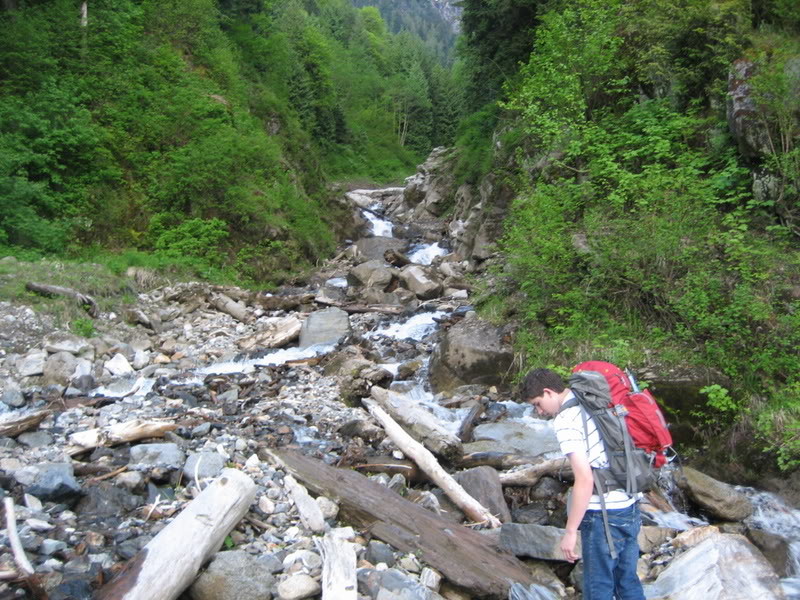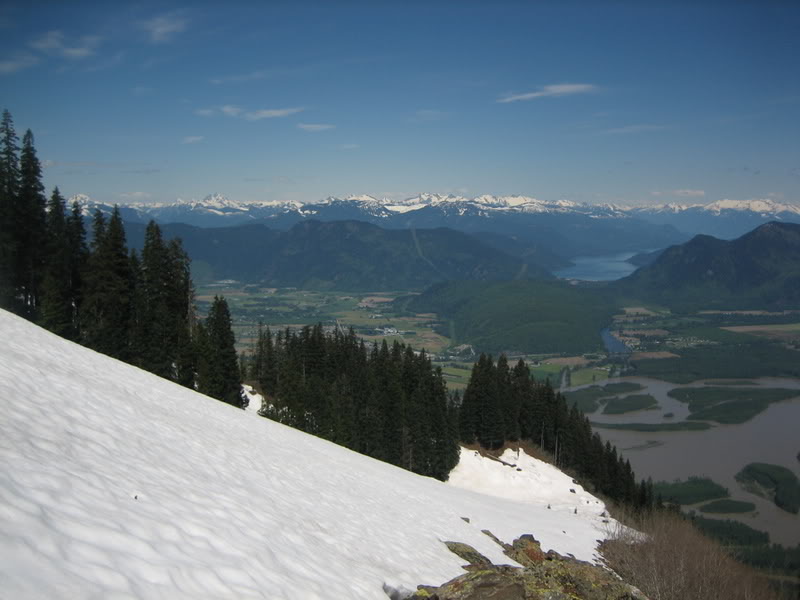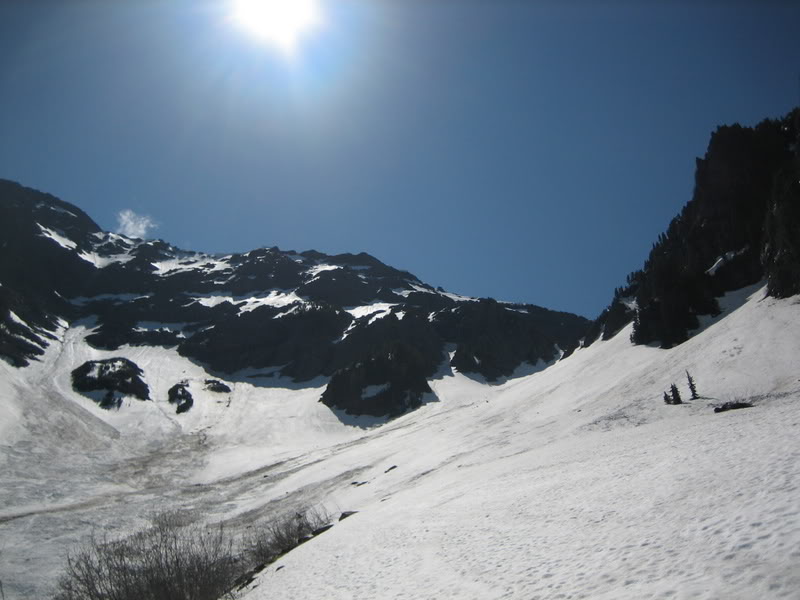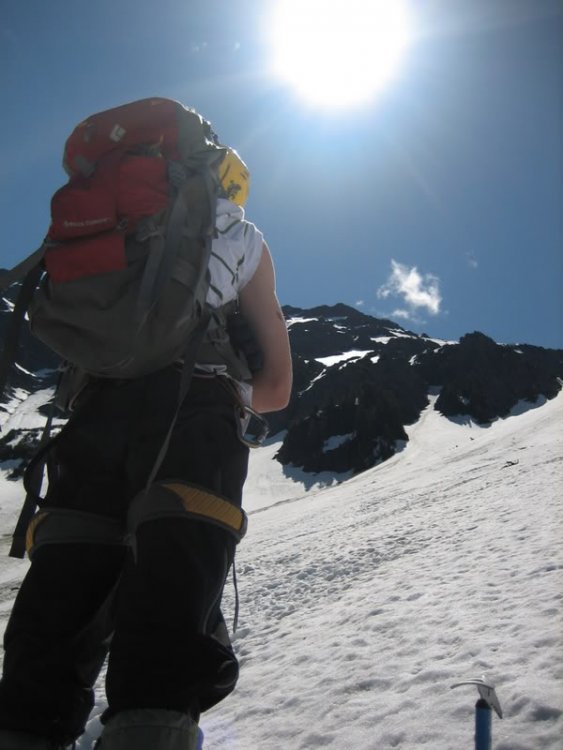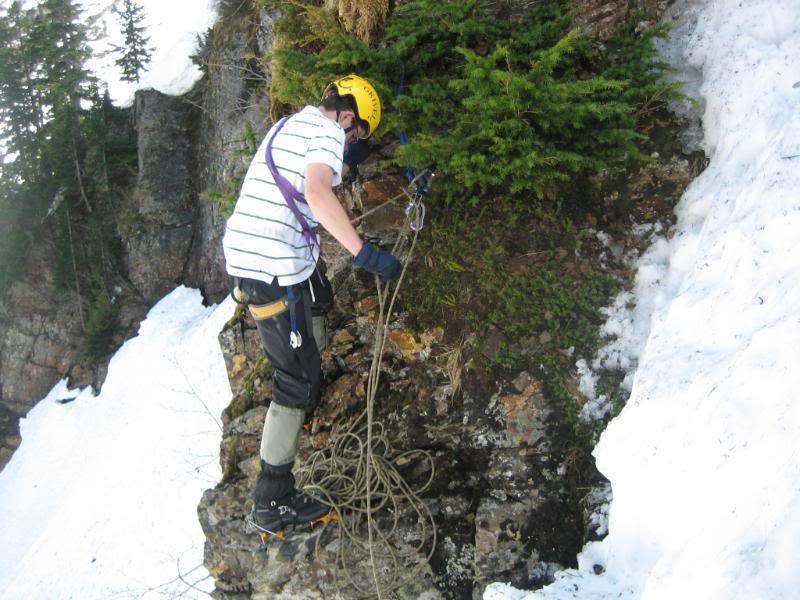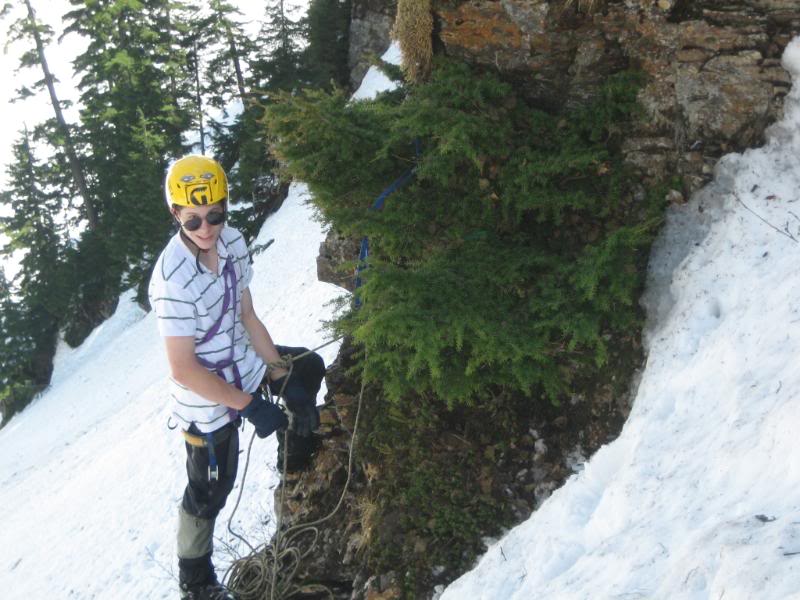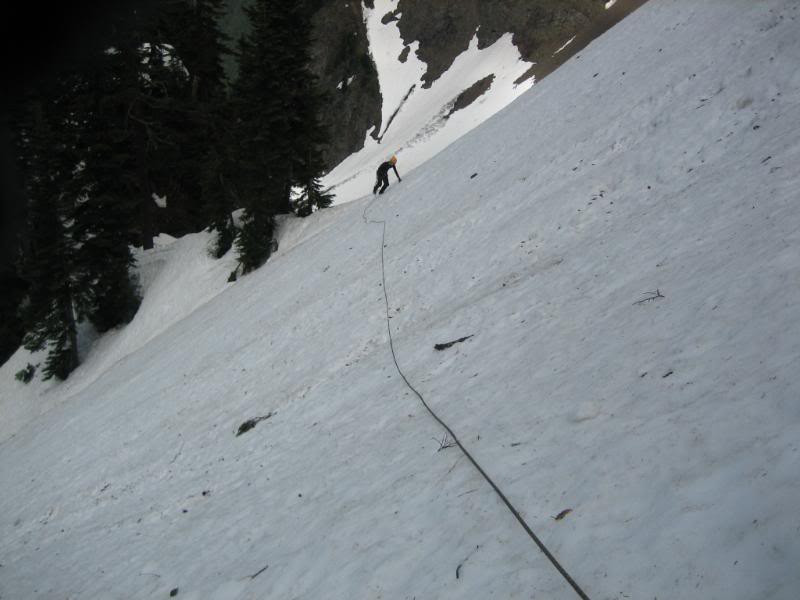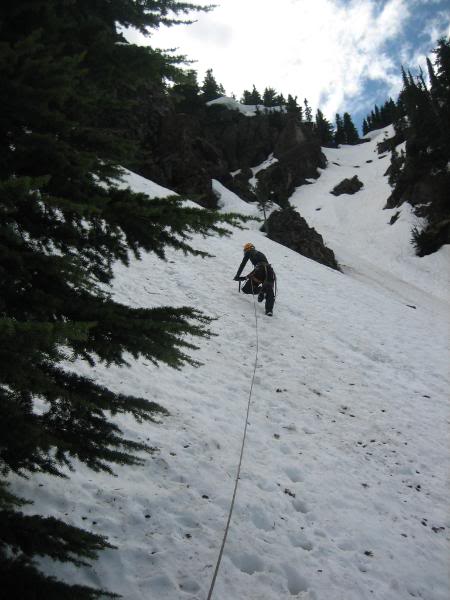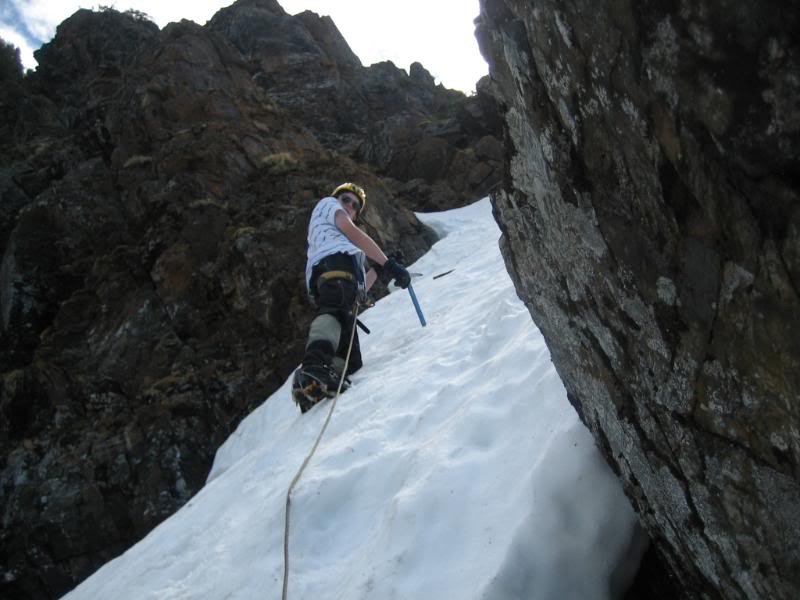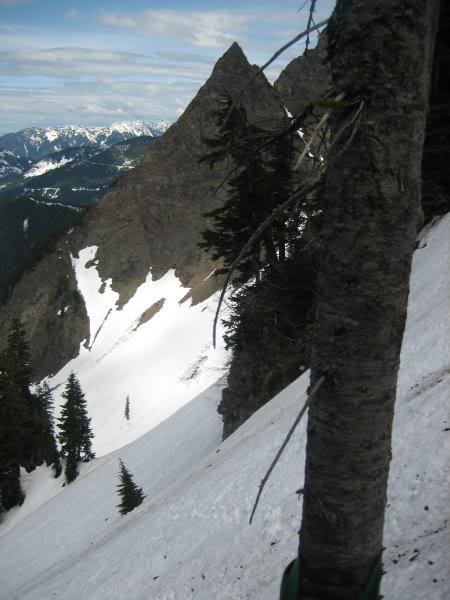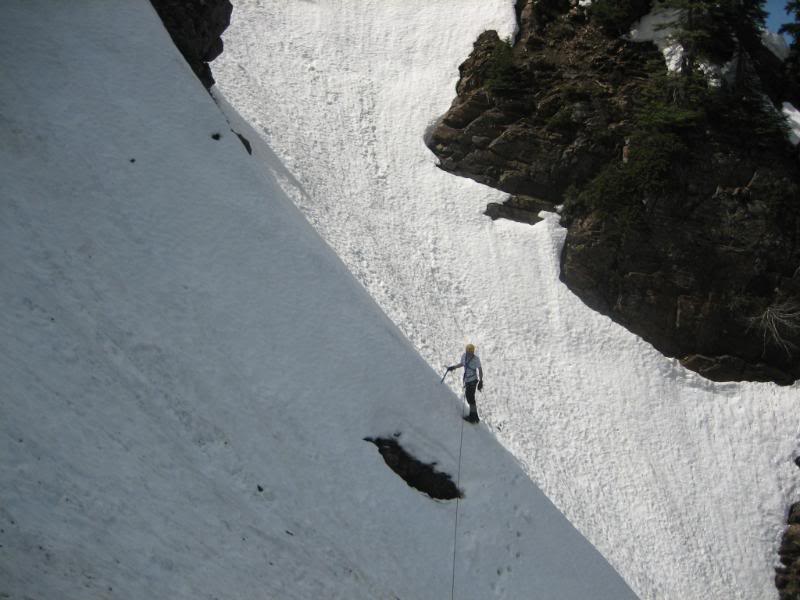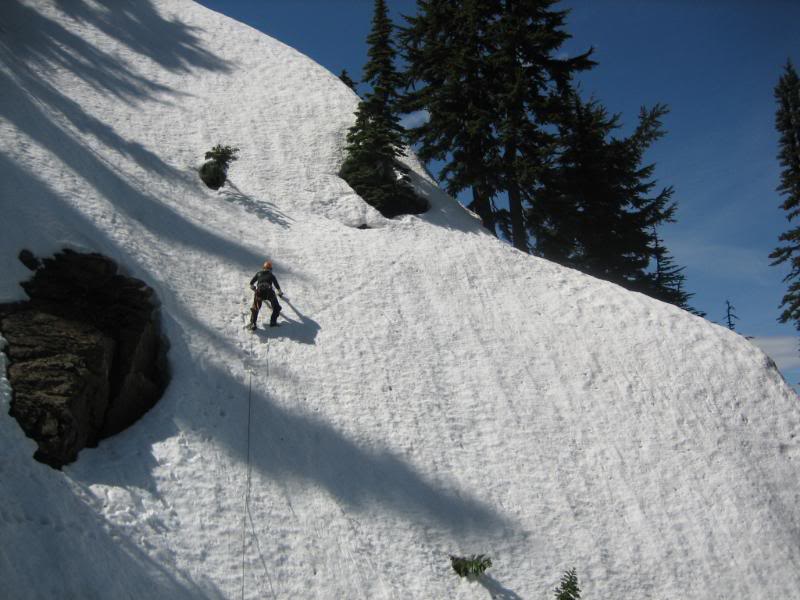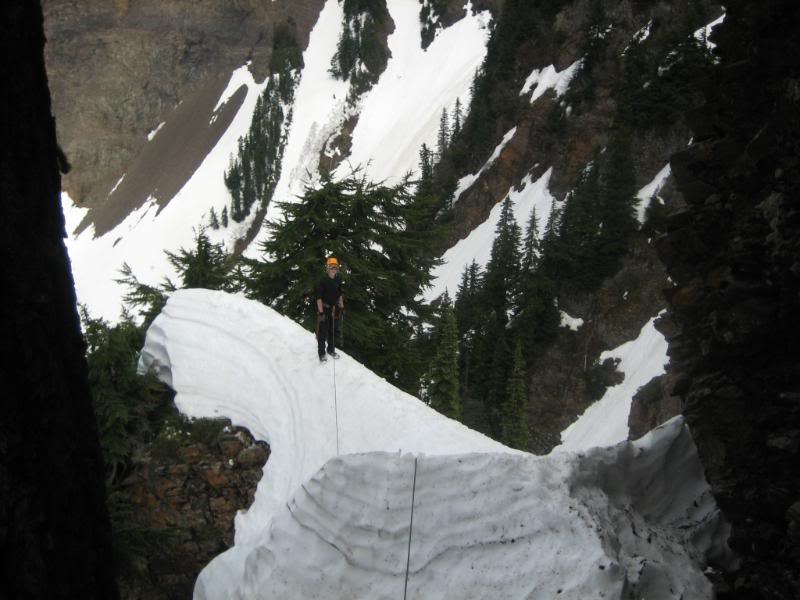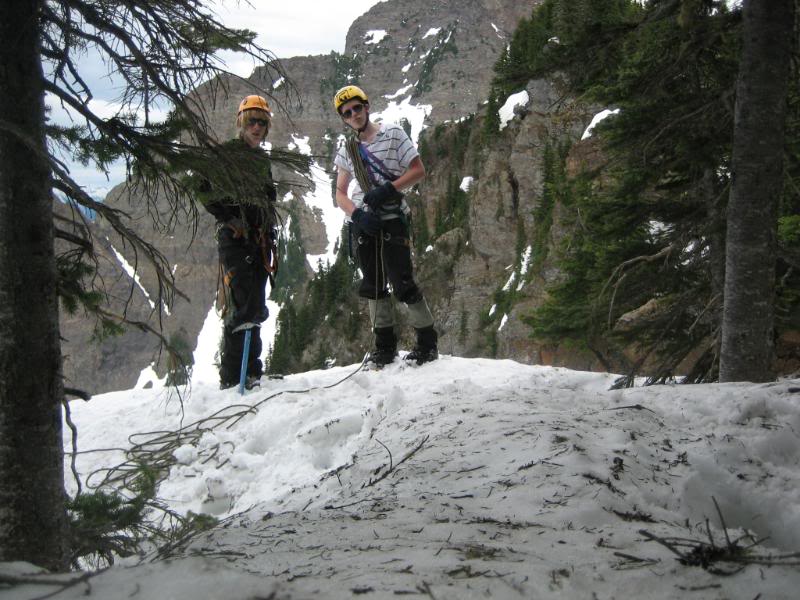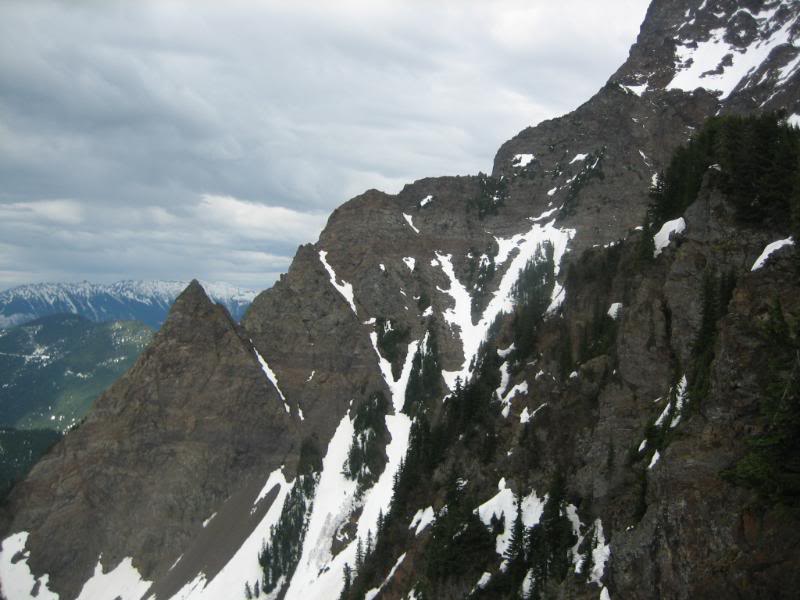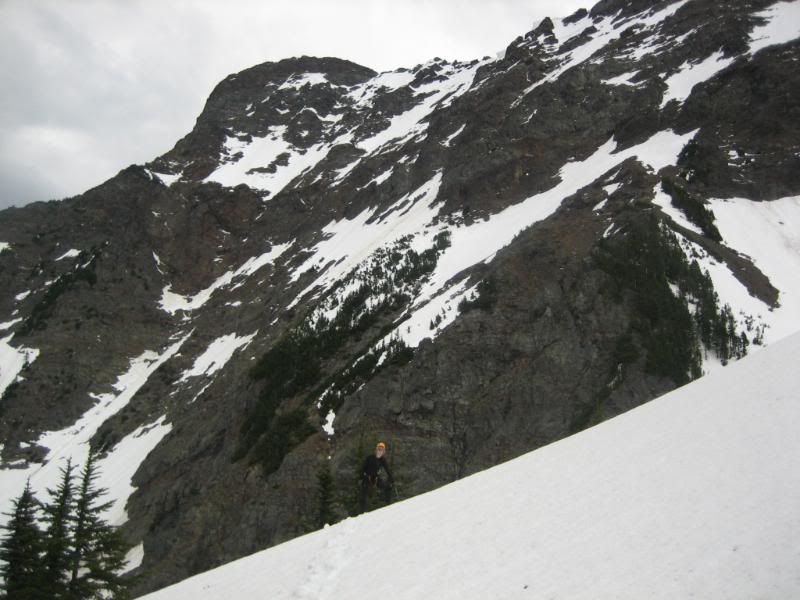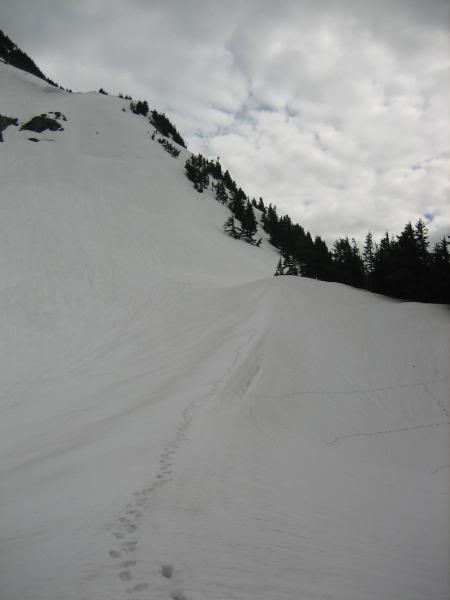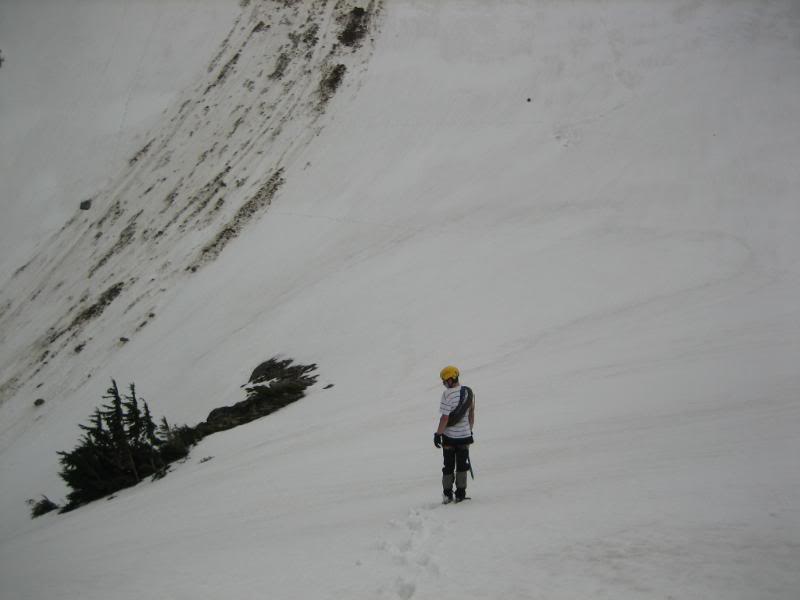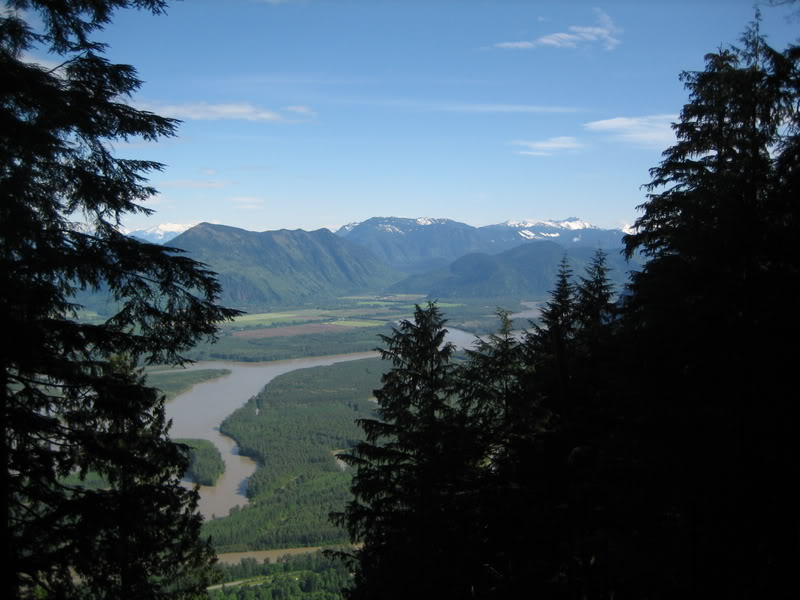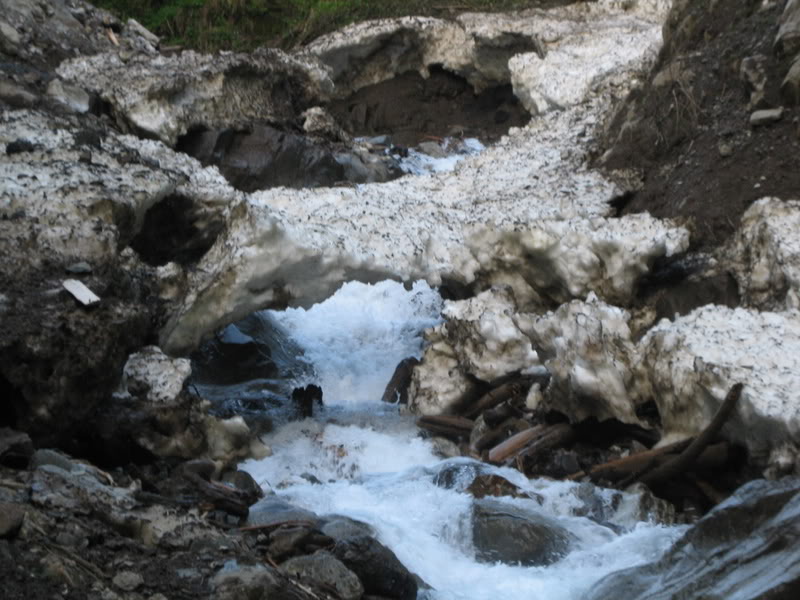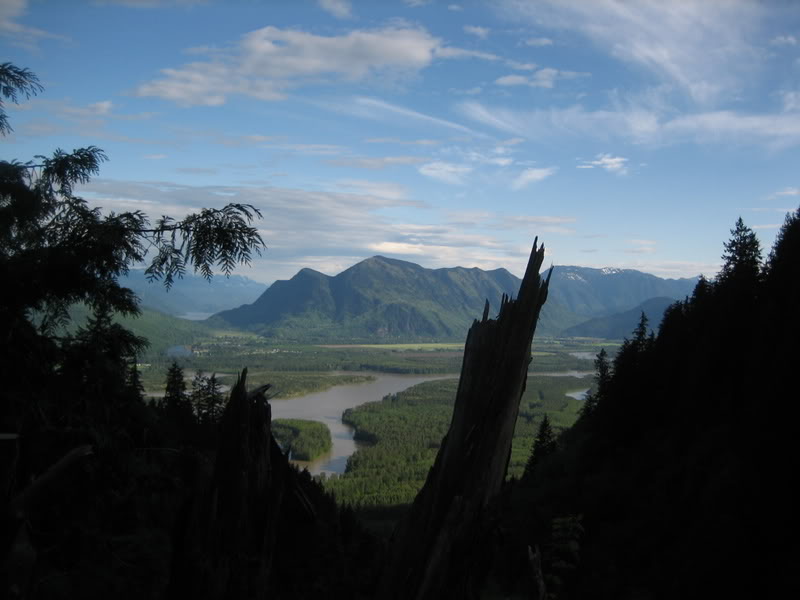Search the Community
Showing results for tags 'best of cc.com'.
-
Trip: Sloan Pk.-(FA)-SE Ridge - Probable FA of the SE Ridge of Sloan Peak Date: 9/7/2008 Trip Report: It was time to follow up on a few lines that I have schemed on in the past. 12 years ago I saw a super steep ridge directly above the Corkscrew route where it exits the glacier. It is the cliff on the right skyline. The Corkscrew (CS) Route is the grassy ramp below. Jared and I mounted a spirited attempt the Labor Day weekend before, only to get snowed out half way up the Bedal Creek approach. With renewed vigor and yet still more clouds, Lane an I went after it this weekend. All clear pictures were taken late Saturday or summit day, Sunday. Seems the west side sogginess was to prevail. With newly soaked shoes, we dispatched the approach . Up high, the clouds began their dramatic uplift. Lane and the "Snowpatch Spire of Washington" Monte Cristo Backdrop We then settle into an amazing bivy light show-yet again I am a lucky photographer lately I know I drove Lane nuts with taking a 100+ photos of him. A cold night led to the same in the am. At 8 am we got after the snow-crossing and the lower ramp and got above and into position to do the obvious Dihedral that caps into a big , crackless roof. Route goes up the Black Blocks(pitch 1, 5.2) on left and into the thin cracks on right of dihedral. Lane following 5.7 , pitch 2 I then traversed right onto the crazy-angled East Face! On to a fist crack, and then into the steep thin face section that also served as the crux. Pitch 3, 5.10a, Reachy, "Reach for the Nickel Pitch" Scary, steep and committing! After a crazy mantel left, I sent the final mossy, wet, yet fun dihedral finish. Pitch 4 , 5.10a. We were then stoked to be at the top of the steep part of the lower buttress. What is amazingly fun about Sloan is the upper bench to the left , lets you "Shop" for your finish. I have done 2 lines now on the SE Face and they have both been 4 stars! Pitch 5, contrived, yet 5.9+ Our route takes the lower left dihedral and goes right and straight up from there > Sloan is a blessed and cursed peak. It is blessed with great granite in places,and soaring walls. It is also cursed with huge ledges and western dampness and weather. I have had several great trips there, and it will be the sight of many awesome routes in the future! Cheers to your future with the highly-accessible -Sloan Peak Gear Notes: Cam to 3, several bugaboos
- 10 replies
-
- sloan peak
- north cascades
-
(and 1 more)
Tagged with:
-
Trip: Colchuck Balanced Rock - FA: The Tempest Wall IV 5.10 A2 Date: 8/28/2008 Trip Report: In order to be a succesful climber in the Pacific Northwest you have to be able to adapt. Plans set in stone for weeks, even months, can be shut down at the last minute with alarming regularity; fickle cascade weather being the main culprit. Such was the case last week as the slowly increasing chance of precipitation crescendo'd at 4 in the afternoon with 100%. Our second attempt at a large north cascades project would have to be postponed, and we were back to the drawing board. Worse yet, blake could ditch me completely and head out on an extended trip amongst clearer horizons in the Idaho Sawtooths. The Enchantments were are best bet and i had to think fast. The Google chat box quickly filled with ideas for the range: Boving Route to Solid Gold, the Girth, Der Sportsman. Blake shut each one down. I was scrambling for ideas when he replied: new route on CBR? i saw a line to the right. It was on, and i was hyped. He claimed thin cracks through headwalls, aid for sure, so we brought the kit and caboodle. The approach was more comical than usual, quite cold, and a bit stormy. The first day we scoped things out, found a line, and fixed the first pitch. Blake threw down a mix of mostly free with a bit of aid, a badass heel-hook, and even placed a knifeblade while free climbing. Pitch 1: We went to bed that night a bit intimidated by our chosen line. The next day we woke up early to a brisk morning and numerous cups of coffee. I taught Blake how to jug on pitch 1: The weather was worse than the day before, clouds were blowing through, and we were being hit by intermittent mist and drizzle. At least we'd be dry under here: What really can i say about the roof. The lead felt like I was in a trance. Did it take me 20 minutes, or 2 hours? I had to stop at the base and ask myself if I really was going to do this. The problem being, enough gear to get me to where? In the end it worked out fine, and yes, I think it will go free, it's mostly gold camalots! Colchuck Reality Crack. Cilogear! Being that it was all the same size i had to backclean our two two's out the last half of the roof and then all the way up to the belay. I tagged them to Blake and he embarked on his first real aid pitch ever. Self-portrait of Blake enjoying a steep learning curve: We named the ledge atop the roof the "yin-yang ledge", and the next pitch which starts with the more moderate aspect of the roof crack, "The Lighter Side of the Moon." Fun free climbing up good dirty cracks. Blake starting out: Myself seconding: An easy 5th class pitch led us to the base of the headwall which began with akward free up a pillar then onto the face. It soon turned to aid up a series of dirty corners and roofs. I short fixed a couple belays when the ropedrag got bad or i needed gear. The finale involved an aesthetic set of triple cracks and brought me to a great stance ontop of the headwall. I was stoked to give up the lead up to this aid gumby: Actually Blake was doing a great job his first day out aid climbing and he pushed us on up the next pitch. Aid through a flare lead to a fun moderate corner crack and a slightly sketchy belay. Darkness fell as I seconded, and i quickly remedied Blake's nest with a solid angle that we fixed. We could tell we where near the top and we really wanted to be off the face. The day had been cold and long and we were getting pretty worked. Aid led up to a dirty wet corner, a heelhook mantle, then a short chimney put me on the ridge, "The Great Escape." I hooted and hollered and then Blake did too. Three simul pitches got us to top and the Tempest Wall was sent. A moderatly painful morning-after was tempered by the idyllic alpine ambience. The Tempest Wall With a scrub, everything but the roof will proabaly go free at 5.11-. I think the roof will go somewhere around 12c or so. It'll be one hell of a fight at the lip. Rack of doubles from black alien to .75, 3 #1's, 4-6 #2's, 2 #3's, a single #4, set of nuts, dbl set of rp's, few pins or not.
-
Trip: Ocean Racing - Pacific Cup 2008 Date: 7/19/2008 Trip Report: I’m not a rock star, I’m just a guy who happens to sail. I haven’t really been active in a year or two, but when the stars aligned and an opportunity arose to sail Pacific Cup with the Portland-based 70-footer Rage, I didn’t hesitate. Well, ok, I did. The last thing you want to do is get on a boat with folks you haven’t sailed with before, and it just doesn’t click. Especially on the ocean! So I signed up with the provision to sail Swiftsure first as a tryout. The forecast leading up to this year’s Swiftsure certainly predicted what might happen. Driftsure. There weren’t any storm systems coming in. Swiftsure always seems like Groundhog Day for Seattle-based sailors: the logistics mean only one or two options to get to Victoria, so depending on your needs you either hop the Clipper or hop the Blackball on Friday. My need was “fast” so I found myself on the Clipper in good company with shady characters Leslie Snodgrass, Ian Beswick, and Mark Bunker. (Yeah, for those of you who don't know, Mark sails!) In short order we landed in Victoria and I made my way to the hotel where Rage’s skipper, Steve Rander, and crew were congregating, and finally introduced myself in person. The race? Well, like the logistics the options are usually only fast and slow, and for those of you who sailed it this year, it was the same for us as it was for you: slow. We escaped through Race Passage, but Saturday was extremely light, with the wind filling in only around sunset from the Southwest near shore. But it was a beautiful day, and we toughed it out on Rage with lots of sunblock. (One can never complain if it’s not raining.) When the wind filled in we finally started having some fun! Coming back from the Bank, we power reached along at 15 knots with the Moon out, the tiller was handed to me for the first time, and I got a chance to get a feel for the boat that I would become intimately familiar with over the coming months. It was …balanced. Driving Rage was like driving a well-behaved Olson 30. There was a little more warning if you were doing something wrong, a feeling I latched onto immediately as critical for night sailing on the ocean. After passing Neah Bay, the wind clocked aft and we hoisted the “Big Doyle”, Rage’s largest spinnaker, at 4,500 sq feet of cloth. (You read that correctly!) With enough sail up to supply a small African nation with .75 oz nylon, we burned down the course and finished in time for breakfast. I was in! Rage during Swiftsure. The strange sail is a jibtop drifter, which is what we had for light sailing before we bought the Code 0 for Pacific Cup. For Pacific Cup, Steve delivered the boat to Alameda right after Swiftsure. It was mostly motor-sailing. The crew started congregating in Alameda a week before the race, to help prepare the boat for the race. This year Rage sailed with 8 folks, including some familiar faces that Steve has sailed with for over 25 years now: his cousin George Gade and his friends Jim Cullison and John Rea. They made jokes about being called “The Geritol Crew” but nothing about any of these guys is remotely old. The other four members of the crew were Portland-based sailors Brian Barnett, Denny Damore, and Joe Bauschelt, and myself. I can still remember how much work and planning we did when I sailed Vic-Maui in 2002, but provisioning for Rage, where the boat and crew that have done the race many times, was far easier: everything already has its tried-and-true place, the menu is the same menu as last time, and everyone knows what to bring. One still has to agonize over spare parts, dive the boat, and finally strip any weight, but that can go quickly the last few days. Before we knew it, we were motoring out to the start on Saturday morning. As we motored up the shipping channel and under the Bay Bridge, the wind built as we’d expected it to. The start was a 3:50 start off Saint Francis YC, just shy of the Golden Gate. It was a typical San Francisco day on the bay, with winds to 25 and foggy conditions. We had left the dock late and only had a short time to get the things in gear, but we got to the starting area with double-reefed main and #4 up, and started on-time with the rest of our fleet. Tacking out under the Golden Gate, as this was my first time, was everything it was hyped to be: on your ear, going out under this huge span, in the fog. Coupled with trading tacks with other 70-footers, it was pretty exciting! But soon the wind eased significantly, we shook out a reef, put up the #3, and started the long reach that characterizes the first several days of a Pacific Cup. Only a few hours from San Francisco, and the fleet parted ways. Rage trading tacks with Flash, a TP52, heading out the Golden Gate. The first two days were uneventful, though very fast, sailing. We settled into our watch routine. Most of the time we plugged away at around 16 knots, trying to figure out how to get the leach cords just right so that our leaches and luffs wouldn’t flap so much. Sea state was rough but typical. Only one member of our crew had a brief bout of seasickness. Eventually we shook out the second reef and then finally on the second evening, when the sailing angles were moving but not quite to spinnaker territory, switching out the #3 jib, the largest upwind sail Rage carries, for a Code 0. The angles on a big boat are different than those of smaller boats because the boat moves so fast through the water that your apparent wind is always forward. Even when true wind is at 160 degrees, Rage is moving so fast that your apparent might only be 120 or even 100 degrees, depending on wind strength. George Gade driving Rage hella fast on the second day. On the third day out of San Francisco, the wind had moved aft enough that the Code 0 was no longer cutting it; time for the Big Doyle. We brought the bag up on deck and hoisted the chute, and presto change-o, we were on our way. Except something looked a little funny with the ‘chute. Hmmm? Oh! We had mistakenly hoisted our smaller, fractional Doyle 2.1oz spinnaker on the masthead halyard. The spinnakers both have the same color scheme, so it wasn’t that easy to tell right away. So we brought up the right spinnaker bag, and did a bareheaded douse and hoist to change to the Big Doyle. Except, on the hoist, the Big Doyle caught on something and we put a huge tear in the foot of the sail. So down came the sail again, we hoisted the spare masthead ‘chute, and we took the Big Doyle down below and started sewing it back together for the rest of the day. During the night, the weather pattern that would remain for the rest of the race materialized: large-scale, squally, stormy weather. Sometime during the night, the masthead halyard block decided to leave this Earth, and our spare masthead spinnaker came down in pieces. In what would become an unfortunately nightly “All-Hands” exercise, we recovered all the soaked pieces of the destroyed kite, and hoisted the 2.1oz Doyle for the remainder of the night. Under spinnaker early in the race. In the morning Steve went up the mast to replace the destroyed masthead block. Later that morning, to our horror, the webbing lashing on the active fractional halyard block failed, and the 2.1oz Doyle came down as well, this time thankfully in one piece. The Big Doyle was ready to go, though, so we hoisted it with great care, and later Steve once again went up the mast, this time to re-lash the fractional halyard block and reinforce the other blocks as needed. With the Big Doyle, Rage was once again doing max-VMG down the course, gaining at least 2 knots of boat speed on average with the larger sail up. Steve Rander up the mast. It was not to last. In the middle of the night once again, Steve rounded Rage up while driving through one of these frequent storm cells, and the Big Doyle’s head ripped clean off, shearing both luff tapes from stem to stern. Each of these tapes is 89 feet long - that’s a lot of luff tape!! We called “All Hands”, recovered the pieces of the sail, and got the boat sailing under the 2.1oz Doyle again. The next day we started sewing. And sewing, and sewing. During the day, as our compass heading crept further and further towards North, we chose to gybe the boat onto port pole and head South. It was the favored gybe and we had to make some Southing eventually. So we gambled. We decided to see what happened and make a call the next day to gybe back if needed. Now, without a sewing machine, 89 feet of luff tape does not get sewn quickly even with 4-5 guys on it, so on this day we only finished sewing about 50% of the tapes. In the afternoon, we saw a sail on the horizon, the first since we’d started! Was it a big boat, or were we starting to pass the slow boats ahead of us? It turned out this was the Cal 20 “Black Feather”, single-handing in a (different) race to Hawaii, sailing wing-on-wing! The boat disappeared astern as quickly as it arrived, and evening came, then night. Sewing. Even before I got up for midnight watch, the boat was overtaken by another storm cell, Rage moved to the next quantum of speed, and Jim Cullison started talking to Steve about a fishing boat on the horizon. Then, when closer, the on-watch spotted the strobes that marked the nets, and Rage apparently narrowly missed becoming entangled in these. The motion of the boat indicated we were going faster than usual and the on-watch was nervous for some reason. I geared up and got on deck. It was pitch black. One couldn’t see anything past the instruments, not even the front of the boat! Brian responded to my concern with “Yeah, it’s been kind of a sketchy ride...” While my driver’s responsibility was rapidly approaching with the watch change, I had never sailed a boat this big in these conditions, so gratefully gave the first turn driving to Steve. Driving Rage like this, at sustained 18 knots with no horizon and only the feel of the boat and a globe compass - the digital compass didn’t update fast enough - felt like driving a missile. A guided missile, and you were the guidance. It was difficult and required complete concentration. A mistake here was unthinkable. My turn came and it was tricky to keep the boat going the right direction. On the horizon, again, we found a very dim but unmistakable masthead light, which we soon passed to starboard and astern. This boat turned out to be Buzz Off, having their own ordeal of a race. After another hour the insanely dark conditions yielded, the wind eased a bit, and we returned to normal. Dawn broke and another full day of sewing ensued, where we finished up sewing the luff tapes. Otherwise, this was uneventful sailing on an empty ocean. We gybed onto starboard again, having made as much Southing as we wanted. We hadn’t seen any animal life (or trash!) to speak of, and aside from the Cal 20, Buzz Off, and the fishing boat no sign of anyone else out here. Another dark, stormy night of sailing was ordered up, and we sailed through Guided Missile mode ‘til dawn still with the trusty 2.1oz Doyle. At dawn we crossed ahead of another big boat on port pole by only a half a mile. Who was it? By now our fleet knew we had gone South, and we had wondered if anyone would follow us. Well someone did: it was Criminal Mischief! We finished patching up the Big Doyle by taping the head, then sewing through the tape, and in the afternoon we launched the sail again. The repair held! I finally felt some positive emotions again, after being depressed for days that we were unable to make any time on our competitors with the trusty-yet-underpowered 2.1oz Doyle flying. That Criminal Mischief was hanging with us (they would go on to finish the race first in our class) seemed just wrong. In the evening, trying to make the big sail last and completely uncharacteristic of Steve in general, we made the call to take the Big Doyle down for the night. We had no sewing thread left, and we wanted to get to Hawaii! It was perhaps a good thing: that night we wrapped the 2.1oz almost hopelessly around the forestay during a period of light air, and it took a good two hours of “All Hands” and strong pulling to get it down the forestay, painstakingly unwrap it, and re-launch it. Rage, moments after losing the top of its mast. In the morning, at watch change, we hoisted the Big Doyle again. I drove for an hour then handed the tiller to George. Perhaps 30 minutes later and 350 miles from Hawaii, we were overtaken by an intense squall, and, this being the first time all race where we got hit by a squall such as this and had the big sail up, the boat started driving forward really fast. Now normally on Rage fast is 16,17, and even 18 knots. But George got the boat to 19.5 knots, when suddenly a large noise from up-top, followed by a funny-looking everything, happened. We looked up. At first we thought a masthead halyard block had been destroyed again, as the sails were still kind-of up but something weird….wait…there was no masthead! The top six feet of the carbon fiber mast had sheared off! The Big Doyle came down, slowly, the mainsail came down, slowly and of its own accord, and we scrambled to bring the sails back on board in one piece. The Big Doyle filled with water, though, and eventually had to be cut away to reduce the rapidly building loads on the boat. That was painful. Everyone took a second to regroup. No one was seriously hurt, but Brian had some rope burns. After a short break, we got to business. We still had fractional halyards, so I went up the mast and jury rigged a new main halyard under Steve’s instruction. We then double reefed the main, and hoisted it, to get under way. Finally we launched the fractional spinnaker, and only 2 hours after we lost the top of the mast we were again sailing at 14 knots towards Hawaii. Steve spent a good part of the day aloft ensuring the mast section, tangled in the rigging, wouldn’t come down and hurt anyone and wouldn’t tear up the remaining sails. We also had to figure out new systems to support various sails and sail controls. Tradewinds. This was on day 8, the day we broke our mast section, and it was the first nice day of the whole race for us. The remaining night and next day to Hawaii were not without additional trials. The wind lightened considerably at times, and our ETA got longer and longer. We got slammed by some more monster squalls, and dodged some of them too. At one point, on starboard pole, I was driving a compass heading of 320 degrees due to these crazy squally winds! This close to the islands, we finally started seeing other boats. We saw Cirrus and the J120 JWorld, and others throughout the day. Then, 100 miles from the finish, while we were having our evening wine and cheese on an otherwise sparkling and fantastic evening, the head ring on the 2.1oz gave out and the trusty sail dropped on deck, still in one piece. We hoisted a reserve fractional spinnaker in no time, determined to make the finish any way possible. Close enough to Hawaii that nothing was going to stop us. After dark we approached Oahu and sailed for what seemed a long time up its windward coast, to the finish line. Somewhere out there over the last miles was a Moore 24 (that had started this race nearly a week before us), and we strained to find them in the murk and confusing lights, to avoid running them down. The finish line was completely confusing, and we only realized we had finished when the Race Committee called us and informed us we had just finished, and asked for our time! Despite being tired, we navigated the unlit channel into Kaneohe Bay and anchored out efficiently, to speed our way to shore where family and friends were waiting for us! So at about 2am local time we all sat down for sushi and Mai Thais, after what anyone would describe as an eventful sail to Hawaii, and told our story. Alex driving with Joe trimming, on the last morning, 200 miles from Hawaii. The squall line behind us would soon overtake us, but we were on the correct side of this one and for 2 hours launched doing steady 16-17 knots. Rage anchored out. Part of the reason we do this: empty beach on the North shore of Oahu.
-
best of cc.com [TR] Ptarmigan Speed Traverse - 8/14/2008
off_the_hook posted a topic in North Cascades
Trip: Ptarmigan Speed Traverse Date: 8/14/2008 Trip Report: Colin Abercrombie and I completed the Ptarmigan Traverse in 18:10 from the Cascade Pass parking lot to the Downey Creek trailhead. We set out at 2:05 am and reached the Suiattle River Road at 8:15 pm. The weather was perfect and the glaciers were in great shape. We did the Ptarmigan in 2004 which was very helpful for routefinding purposes. Location (Elevation): Time Elapsed / Split / Real Time Cascade Pass TH (3,600 ft) : 0 / 0 / 02:05 Cascade Pass (5,392 ft) : 55:03 / 55:03 / 03:00 Cache Col (6,920 ft) : 2:13:13 / 1:18:09 / 04:18 Spider-Formidable Col (7,320 ft+) : 4:59:33 / 2:46:19 / 07:05 Yang Yang Lakes (5,830 ft) : 6:20:09 / 1:20:36 / 08:25 White Rock Lakes (6,194 ft) : 9:50:45 / 3:30:35 / 11:56 Spire Col (7,760 ft+) : 11:54:44 / 2:03:59 / 14:00 Cub Pass (6,000 ft+) : 13:41:32 / 1:46:48 / 15:47 Bottom of Bachelor Creek (2,440 ft) : 16:29:45 / 2:48:12 / 18:35 Downey Creek TH (1,415 ft) : 18:09:36 / 1:39:50 / 20:15 [Car at Milepost 12.5: 20:48:24 / 2:38:48 / 22:54] After doing the car shuttle Wednesday afternoon and evening, we rested at the Cascade Pass parking lot. At about 1 am we were awoken by icefall from the hanging glaciers on Johannesburg. The thunderous noise persisted for over 5 minutes. We set off at 2:05 am and after 55 minutes of walking and jogging we were at Cascade Pass. We continued up Mix-up arm and then ascended to Cache Col arriving while it was still dark at 4:18 am. On the descent towards Kool Aid Lakes we descended a little too low instead of traversing boulder fields. Once we realized the mistake we began an ascending traverse meeting up with the route heading towards the Red Ledge. The Red Ledge was straightforward with no moat issues yet. Once we rounded the corner, we saw the magnificent icefall of the Middle Cascade Glacier as the sun was rising. Mount Formidable. The Middle Cascade Glacier icefall. Sunrise over Formidable. On the ascent to Spider-Formidable col, we had to make a small backtrack due an open bergshrund spanning from rock walls to the right to the center of the glacier. Ascending left of center was straightforward and we were at Spider-Formidable col in under 5 hours from the start. Buckindy Region The steep snow from Spider-Formidable col was quite hard in the early morning and we downclimbed for a couple hundred feet before beginning a fast traverse down to mosquito infested Yang Yang Lakes (the only spot we encountered any mosquitoes). At Yang Yang we were met by a couple climbers who had fallen very ill and could not complete the traverse. We took their contact information and passed on their desire to be rescued to the rangers and sheriff’s office. A quick ascent up to the saddle north of Le Conte Mountain brought us to the awesome traverse over to the Le Conte Glacier with up close views of glacial ice hanging over the rock buttresses and the wild Flat Creek basin. Flat Creek Basin Old Guard and Sentinel At Sentinel Saddle we met Cascade Climbers JoshK and Ivan who were doing a south to north traverse. We chatted for a few minutes and then I continued the walk to Lizard Pass which was amazing with views in every direction. We took a break at the spectacular White Rock Lakes for photography and refueling. South Cascade Glacier Lizard Pass. Gorgeous White Rock Lakes. Dana Glacier Re-energized, we made great time up to Spire Col on the Dana Glacier, which was also in great shape. Sweet contrast. Taking the third gully on skier’s right from the col, we made it down to Itswoot Ridge fast. The classic view of Dome Peak Dakobed and Glacier Peak Traversing the basin down to Cub Lakes took longer then expected and the short but steep climb up to Cub Pass in the 90 degree heat was physically taxing. We thought gravity would take us down Bachelor Creek, not so fast! The upper part of Bachelor Creek is actually in decent shape and you can reasonably follow the path through the slide area. The most difficult section was the lower Bachelor Creek where thick brush made travel very slow. The brush, consisting of salmonberry, slide alder, and a sprinkling of nettles, has gotten thicker since our last visit and affecting a greater length of trail. We finally reached Downey Creek and knew the Suiattle River was not far. After a break, we jogged the final 6.5 miles, arriving at the Downey Creek trailhead at 8:15 pm. We were not looking forward to the extra 8.5 miles of road walking due to the washouts at MP 12.5 and 13, but the road is flat and it goes by fast. Once we started walking we were able to reach the car in less than 2.5 hours, arriving at 10:54 pm. Four summers ago after spending 4 nights on the Ptarmigan we would have never thought to do it in a single push, let alone 18 hours. In discussing this trip, we had hoped to go under 20 hours, but knew it could run longer a la Mount Fury last week. We were able to exceed expectations on the traverse portion, and despite Bachelor Creek taking longer than expected, a steady, consistent effort throughout the trip allowed us to make great time. Knowing the route and the smooth conditions on the glaciers were helpful. We left just enough energy to navigate brush-choked Bachelor Creek. The Ptarmigan is a classic traverse for good reason - the terrain and scenery are amazing! To traverse all of it in less than one day was very rewarding. Gear Notes: axe, crampons, sunscreen Approach Notes: A few snow patches left on the traverse to Cache Glacier. Stay left of center on Middle Cascade Glacier unless you want to jump an opening bergshrund. The brush on lower Bachelor Creek is indeed getting worse. The 8.5 mile walk on the Suiattle River Road is flat, easy, and fast. It is possible to drive around the washouts but it is dicey and definitely not suitable for larger vehicles unless you want to park in the Suiattle River. -

best of cc.com [TR] Meulefire and Indecision - East Face 8/2/2008
Trent posted a topic in North Cascades
Trip: Meulefire and Indecision - East Face Date: 8/2/2008 Trip Report: It has long been a goal, nay, a lifetime dream of mine to climb every peak in the Repulsive 69. To those not in the know, the Repulsive 69 is a list of the sixty-nine most obscure and unappealing peaks in the Cascades. Inclusion in any “Selected” or “Classic” guidebook is an automatic disqualifier for this list. No one has completed the Repulsive 69, as two of its peaks are as yet unclimbed. As far as the race for completion goes, Dallas (aka Obi Wan) has a comfortable lead with sixty some odd. Scott (aka The Moat Master) is a distant second with twenty-twoish. I am unsure of the exact number, he keeps his count secret. Jason (aka Snaffle Bait) is in the running with nineteen. I am trailing the pack with a measly fifteen. Jill (aka Dr. Jill) has climbed twelve, but she has a lot of spare time and could easily catch me. I needed a few of the grand boys ticked this weekend to pad my lead over Jill and gain on Scott. I pulled out the cell phone and started calling prospective climbing partners. What would it be this weekend? Seapho Peak? Berge Mountain? Canadian Border Peak? Or the ever-elusive South Hozomeen? Damn caller ID. Ever since I set my sights on completing this list, most of my regular partners won’t answer the phone anymore. Just when I was ready to give up, the phone rang. Caller ID listed Scott. “Wanna go climbing this weekend?” he asked. “What, couldn’t find anyone else?” I retorted. “Shut up and be at my house at seven AM, and make sure that you are not followed”, was the answer. “Where are we going?” I inquired. “I’ll tell you on the way. I have an FA route scouted on one of the 69”. An FA on one of the 69! This would be our golden ticket to Cascade mountaineering history! I could hardly contain myself. I arrived bright and early at Scott’s place packed to the gills and ready for anything. “Lose the rock shoes.” he said. What was I thinking? This was one of the Repulsive 69, not exactly known for their quality rock. Once out of cell range, he finally revealed the objectives, Meulefire and Indecision, with the added possibility of Little Johannesburg or Repulse! This would be an epic weekend indeed! Fisher Basin The approach to Silent Lakes Silent Lakes. Muelefire in the background. After a quick march over Easy Pass and up Fisher Basin to the Silent Lakes, we dropped our packs and ran up Fisher Peak. To enjoyable for inclusion in our list! The next day we set out for the crown jewels of Grizzly Basin, Indecision and Meulefire. We summited Arriva to check out our prospective route, the North Ridge on Meulefire, and said hi to Mr. C. on the summit. The ridge looked good, but getting on it looked difficult. Too many gendarmes and notches. Well, we would have to get this mighty one via the dog route. The North Ridge on Muelefire After traversing down heather slopes to Grizzly Basin, the real business on Meulefire began. We started climbing what quickly became fourth-class scorist. For the uninitiated, scorist is a combination of forest and blocky scree that is common on sub-alpine slopes in the Cascades. Scorist has ratings from class one to class five, and further gradations reaching 5.9. The rating system is quite similar to the commonly used YDS. I watched Scott pull a figure eight over a u-shaped fir tree, spraying needles everywhere. “Nice move!” I yelled. After the scorist, we emerged to a seemingly never ending field of steep heather interspersed with steps of unusually shattered rock balanced precariously at their angle of max repose. Scorist attained We finally reached the summit ridge and followed to a notch just NE of the summit. Beckey says one lead of 5.2 to the summit. Who needs rock shoes for 5.2? And what exactly is 5.2? Well, in exploring my low fifth-class boundaries, my grade-inflated head was certainly wishing for some sticky rubber! The next 30 meters were enjoyable climbing on surprisingly solid rock! I guess that it can’t all be bad. We topped out and looked over at Indecision. To our untrained eyes, the summits looked to be the same height. A ten-minute scramble took us to the top of Indecision. The last entry in the summit log was from Roger Jung, on a solo traverse from Fisher in 2003. The author contemplates 5.2 The summit of Muelefire. Another tick! Joe and Joan Firey and John and Irene Meulemans made the first ascent of Meulefire in July of 1966. However, Indecision, the higher peak according to Beckey, was not climbed until 1972. The question arises, why didn’t the Firey and Meulemans crew, who were prodigious peak baggers and FAers in their day, climb both peaks when the other summit was only ten minutes away? Beckey’s guide lists Meulefire as a lower sub-summit of Indecision massif. Perhaps this is comeuppance for the Fireys and Meulemans, who nabbed the first ascent of Arriva the day prior in 1966, when Beckey and crew had climbed the slightly lower East Peak in 1940. After a rap off the summit, and an interminable steep scree, slab, and heather down climb, we got lucky and rapped through the scorist to Grizzly Basin. The next day, unable to recall what the traverse to from Fisher to Repulse looked like, we climbed Fisher again. It would certainly be a coup to pull off on ascent of Repulse, the namesake of the Repulsive 69! The traverse had been done the opposite direction by Roger Jung back in 2003, but it was too involved for us on our last day. Oh well, this is how the ball bounces when you are bagging the big boys. We decided to get Little Johannesburg on the way out. The second run up Fisher. Black peak and the N Ridge of Repulse in the background. But like so many of these Repulsive climbs, the mountain had other ideas. On the traverse down to Fisher Basin, Scott slipped and took out a chunk of his palm on a talus block. We limped our way back over Easy Pass under the scornful gaze of Little Johannesburg and to the car for some warm beer. Little Johannesburg patiently awaits our eventual return and conquest. Another two of the proud giants vanquished, and my list closer to completion! Graybeard. A worthy peak but it made Nelson's book. There will be blood The price paid Gear Notes: Forget the rock shoes, eye protection (for scorist), first aid kit. Approach Notes: Over Easy pass, hang a left up to Fisher Basin, take obvious gully up to col, good camping at Silent Lakes. -

best of cc.com [TR] Yosemite Valley - Steck Salathe 7/26/2008
willstrickland posted a topic in California
Trip: Yosemite Valley - Steck Salathe Date: 7/26/2008 Trip Report: TR - Steck Salathe 7/26/08, with Scuffy B. (note: images throughout are lifted from the web, we took no camera) Late 90’s, Camp 4 It’s my first time in the Valley after learning to climb on steep southeastern sandstone. We think we’re solid 5.10- climbers, but are getting bouted by “easy” routes and belay changeovers since we’ve never done anything over 3 pitches, nor anything on granite, nor any cracks that you can't cheat around on face holds. Royal Arches is a dawn to dusk affair thanks to our superb efficiency, but after a few weeks things start to click and we’re firing off the easy classics. After ticking a bunch of 3-star routes, we’re sitting around the fire, swilling cheap malt liquor and wondering what to do as our last route before we have to leave. “Hey, you guys should go do the Steak and Salad,” Matt (a semi-local) offers. “The what? How hard is it?” “Steak n Salad, the Full Meal Deal, Steck Salathe on the Sentinel. It’s only 5.9,” he says, barely suppresing a snicker. The rest of the crew heartily supports his suggestion. “It’s one of the 50 Classics, you gotta do it!” Thankfully, we were feeling strong and opted for the “harder” Serenity-Sons. At some point in the next couple of years I realized that almost all long classics involve at least some token wide climbing. After a religious experience leading p3 on the Kor-Ingalls, and a headfirst backwards 20 foot dive out of the crux of Reeds Direct, I resolve to learn how to climb this stuff, to keep the brushes with death down if nothing else. Burly Ask a group of climbers to describe it, and the word you’ll hear most often is “burly”. The Steck Salathe carries a bigger aura than perhaps any free climb of its rating in the country. “Major sandbag”. “Mandatory on the aspiring hardman circuit” “More demanding than Astroman.” “The hardest thing I’ve ever done” are all tossed out. The number of benighted parties is legion and as the route has changed over the years due to rockfall or things breaking off, the rating became a bigger and bigger sandbag. Are you ready? At some point, as I climbed more wide stuff, the SS became a goal. I knew it would take a lot of work to get my skills in order since I was about a 5.8 wide guy on the sharp end. Luckily, I moved to Josh and hooked up with the Fish. Over the next two winters, he drug me up wide stuff all over the monument. I belayed and watched, asked questions, and then moaned my way up them. Living in the valley in the summer, I paid dues on the 5.10 wide circuit, spent a month in Vedauwoo and got to climb with guys who are both exceptionally talented and love the wide...like Jaybro and Grug. After a February Wide Fest in Josh, I saw Scuffy come within a few inches of choking down the Throbbing Gristle. I casually asked if he would be interested in doing the route this summer. “Yeah, I’ll do it with ya”. Uh oh. We agreed on sometime in July. Unfortunately I started working again in April , blew a finger pulley right after, and had climbed exactly zero pitches of trad since March. Instead I did crossfit stuff, road biked, and bouldered on plastic. Not the best training to say the least. I kept asking myself: Are You Ready? The list of wide climbs I’d done in the last 18 months gave me some comfort, but I’d find out soon enough. The Day of Reckoning I left Redlands Friday morning, and was sitting in El Cap meadow eating pizza by early afternoon. Rendezvous with Scuffy was set for around 10:00 at Hardin Flat. He pops in, we set the alarms for 4:20am and hit the sack. Normally I get a little apprehensive before a big climb, but I feel calm and sleep easily. We both climb enough wide stuff that I figure we’ll move faster than average parties, but we still want an early start to avoid any other parties on the route. We take a single 60m rope, 1.5 liters of water each (somehow I dropped a half-liter on the approach and only had 1 liter for the route), headlamps, a half-set of wires, double cams from blue tcu to 3 camalot and a 4 and 4.5 camalot. Our bivy gear consisted of a bic lighter and nothing else. We both wore pants and a light weight long sleeved shirt. I wore thin neoprene knee pads under my pants, Scuffy went true hardman style with no kneepads. Neither of us wore helmets. We stride up the 4 Mile Trail at an easy pace and reach the base in about an hour. Ro-sham for the choice of leads, I win. I choose evens thinking that will give me the Narrows lead. At about 7:00 Scuff starts up the first pitch. He’s smooth and although the topo says left side in, he goes right side and floats on up. I follow left side in and get a rude surprise at the difficulty of this “5.8” pitch. Damn, this thing is going to live up to the hype. We had planned to link 1 & 2, but I’m not sure if we really did. Either way, I planned to run the next pitch to the base of the Wilson Overhang. I then got off route, back on route, and hosed myself with rope drag. I ended up stopping on a big ledge with a couple of fixed pins mid way up ST p3. The views were already fantastic. I tell Scuffy I've been listening to the hardest, heaviest, meanest music I own for the last several days so that when I get in one of those tough spots, that will be running through my head. And it's true...a steady stream of Motorhead, Ministry, Metallica, Iggy and the Stooges, Tool, etc were my internal soundtrack on this thing. Scuffy started up the first real obstacle of the route, the Wilson Overhang. After a false start or two trying to decide which side in, he dispatched it with a little heavy breathing. It looked hard. Flaring and overhanging, but at least with gear in the back. As I followed this pitch I realized that it can be done a couple of ways...either staying on the outside, with no gear at about 5.8+, or crammed haflway back in the flare at 5.10-. If I had been smart, I would have climbed up, cleaned the gear, down climbed and then went up the outside. Instead I grunted through in the back. I thought the “5.8” squeeze section at the end of the overhang harder than the actual flare/overhang itself.10a? Ok. Next up was the option of an unprotected 5.8 flake, or a 5.9 squeeze that I’ve heard many claim as the true crux of the route. I was planning for the flake. As I reached a spot about 6’ under the squeeze I looked out at a horrendously sloping foot ramp that looked improbable as a place to traverse to the flake, which is out of sight. So I continued up. Next thing I know, I’m committed to the squeeze, left side in. Everything is going ok until I can’t fit my chest through the squeeze. I try to exhale and move, no dice. I look right and see the flake and that the sloping foot shelf was indeed the move. “This is becoming a comedy of errors on my part” I think. I take tension, swing out right and latch the flake. “Unproteced"? Bullshit. The flake is slightly flaring, but does take gear and is easy for 5.8. Scuffy is forced to follow my jingus action since I had gear in just below the crux of the squeeze and then nearly the same level in the flake. I’d hosed him and he had to climb up part of the squeeze, slide back down, and then do the flake. So far, I’m not holding up my end of the partnership. I’ve had the easy pitches and still fucked them up. Scuffy runs the next pitch through the 5.8+ ow, about 4”, which is not too bad with some good footholds on the face next to the crack. The next couple pitches to the top of the buttress are unmemorable rambling up discountinunous cracks and jumbled blocks. We stayed to the left. The ST topo shows a 5.6 squeeze just prior to the tunnel through. We see what looks like 5.6 squeeze above and Scuffy heads up, soon topping out on the flying buttress itself....As I follow and reach the tunnel through spot, I realize our mistake. I recognize the tunnel from a pic I’d seen somewhere and continue to the top of the buttress. We rap down to the bivy ledge and pull the rope. The bivy ledge is pretty deluxe. Then we look down the last 10 feet to the start of the next pitch, DOH! We fucked up again. Make sure you rap to the bolts at the start of the next pitch. Luckily there was a passage/tunnel off the ledge that traversed sloping loose dirt with a slip guaranteeing a quick trip to the base of the Sentinel, that led to the base of the pitch. Here it is just behind the climber, and again from below (both from Zander’s excellent TR) At this point, we were already feeling incredibly worked. I had been rationing water since after the Wilson and knew it was going to be a big issue for me since I couldn’t eat/fuel without something to wash it down.The way we’d pitched it out was different from what I’d imagined when choosing odds or evens when I won the ro-sham-bo. Instead, I would get this pitch , Scuffy the slab, me the supposed crux, Scuffy the narrows. “Hmm, this is probably actually better for me,” I thought, since slabs are not my strong point. I peeked at the topo...5.9 fist and lieback, stance, 5.8 lieback, casual. I bust through the “5.9” and it seems light duty, but cool climbing with gear about anywhere you want it. Then I reach the “5.8” lieback. Looking back now, this was probably the technical crux of the route for me. I found it an incredibly insecure couple of moves groping and trying to pull into a lieback off a flake/ear feature way above my head and pasting feet onto blank vertical granite, above bad gear. I came fairly close to pitching off. As Scuffy is coming up I sense he is at that spot since he stops to puzzle out the move for a second. Next thing I know “WHoa!” jingle jangle wham. Damn, he pitched. But in 20 seconds he’s already pulled back on and finished the pitch without further ado. Our belay is just below this overlap, so as Scuffy leads out on the slab I can’t see anything. Soon he’s finished the pitch and I start following. Not too bad at first, then I unclip the last pro before the move to the hole. I’m looking at a longish penji fall if I blow this, so nervously smear with no hands to step into the hole. Thankfully everything sticks. The rest goes easily enough with a smeary move at the 5.9 crux that is typical for the grade...pure faith in your feet with little or no handholds. This pitch probably protects better for the leader than the follower...something to consider if one of your team is weak on slab. I look up at the next pitch, the supposed crux, and decide it doesn’t really look too bad. Getting a little bit of a second wind, I start up. A tcu goes in a seam, the 4.5 just above, and I commit to the flaring squeeze. It’s hard and slow work, but not too technical or awkward. After about 20 feet you get a nice respite when you can cram your ass in and rest. Just above is the first of the hangerless “bolts”. I don’t know what the fuck this particular piece of hardware is, but it ain't a bolt. Looks almost like a slightly larger star-dryvin type nail in a sleeve. This one is very confidence inspiring since the “nail” part of the thing sticks out about an inch from the end of the sleeve , the sleeve is split, and the whole thing slopes downward about 20 degrees. If anything could use an upgrade, it’s this museum piece timebomb. Sliding a nut over it, I started to sense the seriousness of my situation. “Just concentrate on moving upward” I chanted inside my head. One move at a time, keep your breathing in check, and always Rule #1 (don’t thrash). The pitch looks like this: Another 15 feet or so higher is the second hangerless rivet thingy. It also sticks out out of the sleeve a bit, but looks much much better. I’m psyched to clip it. The pitch soon eases off in difficulty, if not in effort required. By now, my throat is completely raw and my uvula is swelling, touching my tongue and making me feel like there is something caught in my throat and that I have to swallow continuously. It sucks, but as I keep saying to Scuffy “I’m getting what I came for...a first class ass kicking”. Scuffy follows smoothly and steadily. Next up, the fearsome Narrows. Everyone has seen the pics of people getting into this hole/squeeze, so here’s one looking up into it: Scuff places the 4.5 at the lip, moves up as high as possible in the back-foot , places the 4 a little higher, and commits. The next few feet are rough. After struggling for a good 5 minutes and making and subsequently losing about 6” of progress several times, he questions if he can actually climb it. I try to encourage him but I know his abilities and if he is having problems, it doesn’t bode well for me either, and I know he can sense that in my voice. I tell him to just yard on the 4, but it is too far to the side to really do any good. After much struggling and a little cursing, he’s in the beast and motors to the top. In my state of fatigue I figure I only have one shot to get this done without resorting to aid. I get my torso in and recall Yo’s advice “be solid on arm bars, it’s like arm bar campusing without feet for a few moves”. And that’s just about what I did, a few alternating arm bars and then you get a decent edge that’s hard to use. I manage to go from pulling down on the edge to rotating into a chickewing with a palm on it and further turning it over until I’m almost mantling it from a chickenwing. A heel toe goes in and I’m in there for good. The only problem is, after moving up a few feet. I can’t turn my head and can’t fit through. It all looks the same width to me so I yell up...”which way at the tighest spot, left or right?”. So I move over a foot or so and squeeze through. Now, whoever rated the bit after you exit the squeeze until the end of the pitch is a sadistic bastard. Topo says 5.7. Ummm, yeah. BULLSHIT. Felt like insecure 5.9 to me and I was on TR. At this point I’m destroyed. Just fucking wrecked. I’ve only felt this way once in my life and that was trying to get October Light in Vedauwoo clean on TR after Grug onsighted it like it was 5.8. My face was numb and tingling, I was sort of giggling, dizzy, and felt like I’d taken about a half-tab of acid and some narotics. It was a welcome feeling knowing the worst was behind us, but looking out at the valley it seemed like it we were losing light quicker than I expected. In reality, the valley has filled with smoke during the day having been clear that morning. The sun was just a barely visible red orb amidst the smoke. The next pitch is another long assed, runout but very easy 5.7 chimney where you squeeze behind a couple of chockstones and belay on the top one. When I called off belay at the top of this one, I just wanted it to be over, wanted my mommy, a blanky, and a nap. As Scuffy joined me, I thought we had a 50/50 chance of finishing this thing in the dayliight. Since everyone says don’t try the descent for the first time at night, and since we were both completely out of water and suffering from it, I really wanted off this bitch NOW. I knew the next two pitches would link and told Scuffy “go all the way to the tree”. He blasted through the 5.7 mantle pitch, only slowed down slightly at the 5.9 flakes seen here: And was soon at the base of the last 20ft or so of 5.7 double cracks leading to the tree ledge. And then time stood still. What I didn’t realize was there were two different sets of double cracks about 5’ apart and Scuffy had basically no gear for either set and didn’t know which was correct. After a while it was basically dark and I started yelling at him to get moving, aid it if you have to, etc...little did I know what he was actually facing up there...no gear, dark, horrendous rope drag, etc. I follow and keep right on going up the last pitch. Right as Scuffy joins me on top and we untie, I start dry-heaving from the dehydration. It’s a horrible feeling, wretching and writhing and knowing there isn’t a damn thing in my stomach to throw up. “We gotta get down to the creek, I can’t stay up here like this” I tell him. “You ok with that?”. He’s game and we soon start down the descent...in the dark...first time for both of us. I have to stop every 10min and sit for a couple minutes to keep from dry heaving more and to get some juice back in my legs. The descent is actually very easy since I’d read several different descriptions of it and knew more or less where we were supposed to be going. We reached the creek after about an hour. Now with water, we rested a bit, I choked down a gel and continued. A couple of well placed cairns made the slabby section no problem and in another hour and change we were back at the 4 Mile. I spent the next two hours sitting in the Lodge lobby sipping down 3.5 liters of diluted powerade until I finally had saliva in my mouth and urinated for the first time in about 12 hours. It was physcially the hardest day of my life by a wide, wide margin. Go get some. Gear Notes: We took smaller half of a set of nuts, double blue tcu to 3 camalot, single 4 and 4.5 camalot. Approach Notes: Up the 4 Mile Trail to just before the creek, then talus and 3rd class ramps to the base. -
Trip: Prusik Pk. - Solid Gold III 5.11a Date: 6/14/2008 Trip Report: Wanting to get as far away from the sherpa glacier as possible and equally motivated by this, and this, this past saturday, Dave Elder and I climbed Solid Gold on the south face of Prusik Pk. We'd have to agree with first ascencionest Wayne Wallace when he describes the route as a "masterpeice" as we were truly amazed by the flawless rock and splitter climbing. The topo was great and so was the rack. We didn't use the 1/4 incher at the first belay, and we didn't nail because we missed the last pitch entirely. I started up what I thought was 5.8 cracks that led to the perfect 5.11a corner, and, before I had a chance to second geuss myself, was soon cranking out a 10c "changing corners" style variation that topped out on the ridge. Though the new variation is rad (right of the 5.11 corner), anything described as perfect on this route is worth another go, and i'm sure it won't be long until i'm slogging out there again... Dave starting to feel the stoke: One hell of a crag, the impeccable south face: Holy crap, P1, the solid gold pitch: Here's looking back down at P1, fingers in a corner, bad ass: Myself seconding P2: Beginning P3, we easily linked P3 & 4: The P4 "changing corners" variation: Topped out on the west ridge: The really cool thing about this climb, is that its actually just the hardman sit-start for the classic west ridge: Insert monkey call here: BOOM! Gear Notes: Double set to #2, single #3. One rope. Approach Notes: Mostly snow free to upper snow lake
- 42 replies
-
- alpine lakes
- prusik peak
-
(and 1 more)
Tagged with:
-
Trip: Two White Boys on a Big White Hill - Cheam Peak - Random NW couloirs Date: 5/24/2008 Trip Report: So.... I was thinking of going and doing an alpine route last weekend but the weather was going to be super hot with frequent avalanches... I ended up going to a youth confrence in Chilliwack instead. I had e-mailed my friend Jared from mission to go climbing last weekend and when the trip was cancelled we postponed the trip to this Saturday ... our plan was to climb up to the NW bowl of CHeam peak and then hike low angled snowslopes to the toe of the West Ridge to gain the summit. He picked me up at 6:00 at my house and we drove over to the pulloff from the highway where we were to begin our ascent.. We hiked up the creek draining the NW bowl and then moved into the trees to avaid some huge cliffs in the gulley, It was a major slog but we eventually dropped bak into the gulley (now filled with snow) to gear up and hike into the NW bowl... we started up the gulley and just as we were about to get into the NW bowl we got a phonecall.. my other climbing friend Lorne said, "if you look up towards the toe of the west ridge what do you see", and I was like, "holy crap! Its you!" He and his Dad decided to run up to the west ridge earlier to ambush us for no apparent reason.. they didnt go to the peak but they left a cool pattern in the snow for us to look at. We talked and they took off down while we kept climbing up the NW bowl... it was getting hot in the sun and we skirted around the west side of the bowl so we wouldn't get killed by stuff falling on us, it got so hot on the snow that we had to stop and take off our pants and wear just our gore tex shell pants with boxers underneath. We eventually started getting bored of doing the easy snowslope route that Al and Lorne had done so I started looking for an alternative. There were some rock towers above the west side of the bowl and it looked like there was a cool gulley going in between them so we set off to climb this mysterious gulley. We ditched our packs at the base of the gulley and Jared set up a quick belay with my lucky tri-cam and his ice axe. The belays were not really nessecary in the first gulley but we had lots of time and used them anyways, all we had brought was an 8mm, 30m scrambling rope so I led up 30m to a tree sticking out of the snow and belayed Jared up and past me another 30m where he set up a makeshift belay with his ice ax. We stuck to the shady edges of the Couloir where the snow was firmer and less sketchy.. I led up again and set up a belay on a couple crappy bushes and then Me and Jared did some simul-soloing to the top of the first couloir. From the top of the first couloir the slope joined another steeper snowlope going up towards the ridge crest. We switched leads and diagonally ascended the slope for a few more short pitches. Jared's final lead to the crest was quite steep (60 degrees) From there we climbed a cool ridge and up a last short slope (with a vertical buldge of snow) to the toe of the weat ridge... It was getting late and we didnt want to slog all the way to the top so we glissaded and plunge stepped down easier angled slopes back to our packs and then hiked all the way down the trees and creek back to the car at the Highway. Overall the route was super fun with plenty of excitement but not at all scary... there was no gear on any pitches, we climbed from belay to belay. Approach Creek Old Snow Bridge Cliffs in gulley Almost in the NW bowl Our route starts in between those rock towers Slogging it out in the Bowl Crap bush belay Starting second snowslope, above the couloir Jared Leading on the second snowslope Heading up more steep snow, Yes Im wearing aviators Looking down the second snowfield Red Pyramid Me leading a super fun section Jared on a steep section Final Ridge Posing at the top of our climb Big Cheam Packing up Snow Pattern Descending Gear Notes: A few slings for tree belays, light rope, ice axe, crampons not nessecarry... aviator sunglasses and my lucky tri cam are a must! Approach Notes: Up drainage to big cliffs, up forest to bowl... up snow to couloir.
- 53 replies
-
- best content
- cheam
-
(and 2 more)
Tagged with:
-
Trip: Wyoming Mashup - Date: 5/20/2008 Trip Report: *Not sure if this belongs here or in the ice forum...? Summary: Day 0: PDX -> SEA -> BZN -> Yellowstone National Park Resort Day 1: The Silver Cord (3 p/175 m), Yellowstone -> Devils Tower Day 2: Devils Tower: Bon Homme (Horning Variation), Belle Fourche Buttress (1st 2 pitches), One way sunset (1st 2 pitches) Day 3: McCarthy North Face (4 p) Day 4: Devils tower -> BZN -> SEA -> PDX Details: So after a great start to ice season it all came to a grinding halt when I took the plunge to purchase a second home and rent my first one (JayB enter stage left ). Two months of looking/inspecting/bidding/closing/packing/moving/unpacking/renting/etc etc flew by and suddenly it was May! Shit! Where did ice season go!?!? I wanted (needed???) a last ice fix before summer set in and it sure wasnt going to happen around here. I needed a partner and some ice pronto. I tracked down Bryan who had just finished his first semester of grad school unscaved and begged him into a little ice climbing. Made some calls and sent some emails and determined that assuming the road was open the silver cord would likely be in. The Silver Cord Cascade: Yes not my photo. And no I dont know the difference between a cascade and a waterfall. The story with the Silver Cord is it is located in the grand canyon of Yellowstone National Park... the Cord most definitely forms every year however as the Park doesnt plow the roads in winter one either has to have a sled and/or ride the snow coach in addition to skinning to access the cord. Basically the math is 3 days for 175 meters of ice. So why not just wait until the road is open? Most years by the time the road is open/plowed the cord has already melted out. Due to these logistics involved the cord hasnt seen many ascents even though it checks in @ WI3+. But we were in luck! The road was open (so they said... more later), the temps looked good so I packed my bags, threw in my rocks shoes in case the predicted west coast heat wave made it out east and hopped a plane to BZN. Bryan grabbed me @ the airport and we headed south. We managed to get to the park just before dark. After some sleep we go back up and left the car by 5 am... we found the road wasnt actually open as far as they said it was so we walked some road to the trail head. As one walks along the top of the canyon rim you end up rapping down the cord and then climbing back out. We found the cord using JoJo's excellent beta, rapped the route, climbed and were back to the car by noon. Grand Canyon of Yellowstone National Park: !!! Pitch 1: Pitch 2: Pitch 3: Water ice in May... gotta love it. We were hoping for some more ice so we called Jay @ the Silvertip Mountain Center to see how things were holding up @ Cooke City. Jay told us things were sliding and it was suppose to be 60 tomorrow... alas: good bye 07/08 ice season (though I hear Cali Ice is still in!) After a quick soak in the boiling river we headed east for the devils tower. Boiling River: Gotta love the natural hot springs Moo? We made it to Devils Tower by 11 or so... I'd never been to Devils Tower before so Bryan ran me around the next two days on a mini sampler of the tower (emphasis on mini... the tower is HUGE!). Stem box: Wide: Hands: 5.5 my ass: Tips to hands: Woof? McCarthy North Face: Tips to ringlocks: Summit views: MisterE: eat your heart out Epilogue: So yeah: devils tower is worth the trip... I'm hoping to get back out there this fall. Hundreds of multipitch trad routes! Cheers to Bryan to another great trip, JoJo for great beta, and Frank for letting us dirtbag at his place Gear Notes: BEAR SPRAY! We saw lots of grizzly tracks
-
Trip: I Love the Desert Date: 4/28/2008 Trip Report: This spring I was fortunate to make a really fun desert Southwest tour with my wife Michelle and a few other friends. We visited Colorado, Utah, Arizona, and Nevada. During the trip I climbed 32 desert towers and a half dozen other routes. First stop was Colorado National Monument. It was pretty cold, but we managed to climb Independence Monument, Otto's Route (III, 5.9). Colorado National Monument, with Independence Monument on the right: A close up: The route was pretty "cool" with snow all over the ledges, But fun none-the-less. Love the history of the route with all the manufactured holds and staircases. You can see one of the staircases in the pic below, and Michelle is grabbing on to an old pipe hole: With temps dipping down to 10-degrees, we decided to head farther south to the Moab area. We did a quick climb of South Six Shooter, South Face (II, 5.8). On South Six Shooter Peak, with North Six Shooter in the distance. It snowed on us, so dreaming of warmer weather we decided to head farther south into Arizona. We had long wanted to climb in the Superstition Mountains outside of Phoenix. The Superstitions. The Hand, the Tower, and the Prong are the first three towers on the lower left. The larger Grandfather Hobgoblin Spire is on the right, but blends in a little with the cliff behind: The rock at the "Supes" is really interesting, some kind of crazy conglomerate. The protection is often sparse, and when there are bolts, well... One of those plant towers: The first day we did a collection of towers on the northwest side of the range. We climbed The Hand (5.6), The Tower (5.8 R), The Pickle (5.4), The Periscope (5.4R), and The Prong (5.6). All of them were unique little climbs and summits. Very cool. The Hand: Here is Michelle at a small belay on The Hand. The 3-pitch route we climbed was called the Razor's Edge and the climbing was on a 3-foot wide, steep ridge crest: The Tower had 25-feet of unprotected, overhanging 5.8 climbing to start the route, then a long and thoughtful 5.7R pitch above that. It felt good to get on top of that sucker. The Pickle was fun - it looks steep and hard from the base but it really is only 5.4. The climbing is on huge cemented together conglomerate rocks. Michelle rapping off the Pickle. The next day we woke up for two more climbs of Grandfather Hobgoblin (III, 5.9), and the really fun North Buttress, Spider Walk (III, 5.6). Here is Grandfather Hobgoblin, the 4-pitch route climbs up to the notch on the left, then right up to the summit: Looking down at Michelle atop the first pitch: View from the summit out towards the suburban sprawl: After rapping down we went directly over to the North Buttress. Spider Walk takes an improbable looking line (for 5.6), meandering up 4 pitches of run-out slabs, with hard to find bolts, then up a chimney/crack system up a very cool feature. Here's a shot of the North Buttress. The route starts on the left side, then works its way up to the chimney near the top: Michelle following the second pitch: At the end of the route, you can scramble up to a high spire that overlooks everything. A final sunset: Next stop was Red Rocks, Nevada. We spent a few days climbing Dark Shadows (5.8), Frogland (III, 5.8), Sour Mash (III, 5.10a), then met with our good friends Chin and Raleigh and climbed Eagle Dance (III, 5.10c A0) and then a twisted variation of The Gobbler and Yellow Brick Road (III, 5.10c) on Black Velvet Wall (this to bypass the cluster on Dream of Wild Turkey's and other routes). Hiking up to Eagle wall: Me leading the second pitch of The Gobbler, with Raleigh belaying: Michelle following Sour Mash: All in all we had a great week in Red Rocks, with splitter weather and pretty moderate crowds. Next stop: Zion. I really love Zion, and this is partly why: We only had a chance to spend two days here. The first day was a bit of a lazy day. We rode up canyon in the shuttle and climbed The Pulpit, Original Route (5.9, C1) - a cool little spire at the end of the road. Here's Michelle following the one and only pitch: Day 2 we climbed the Iron Messiah (III, 5.10) a 10-pitch route on the Spearhead. You gotta love chimneys to like this route: High on the route (see Michelle at bottom of crack and shuttle bus below), the second to the last pitch was a stellar 200-foot corner. It had been a few years since visiting Zion and I was really psyched to climb there again if only for a couple days. Michelle had to head back home and my buddy Jim flew down to meet me for some climbing around Moab. Our first stop was the Bridger Jack Towers in Indian Creek. In two days we climbed Sparkling Touch Tower (5.11-), Thumbelina Tower (5.11), Sunflower Tower, East Face (III, 5.10), Easter Island Tower (5.10), and King of Pain, Vision Quest (III, 5.10+). Shadow of the Bridger Jacks on the desert floor: Jim's picture of me leading Thumbelina, a great single pitch of 5.11, and a cool spire to boot! Jim's picture of me leading the first pitch of Sparkling Touch: The King of Pain. Vision Quest climbs the split between the two towers: Here's Jim in the 5.10 slot on Vision Quest. After this pitch, I won't disagree with the guidebook description calling the route "burly". Jim taking the lead on the last pitch of Sunflower Tower. South and North Sixshooter can be seen in the distance. I was psyched to finally climb on these towers. The ease of access, quality rock and routes, and relaxing atmosphere made for a great couple of days (and a great warm up for Jim!) Next we headed into Canyonlands National Park. We stopped by the ranger station and got a permit to camp down on the White Rim for a couple days, then later that afternoon we climbed Washer Woman, In Search of Suds (III, 5.10+). The route was super-classic just like everyone said it would be. Gotta be one of the most unique looking towers in the desert. Can't wait to see what it looks like when that chock stone falls out! Washer Woman and Monster Tower: Looking down from the last pitch, with Monster Tower behind: Jim's pic of me leading the final summit block: Gotta love that rappel! Next we headed into Monument Basin. Our first objective was the ultra-classic Standing Rock, Kor Route (III, 5.11). You can tell this route gets climbed a ton because there is no loose rock or mud typical of the area to speak of. I can only imagine what it must have been like on the first ascent. Jim's pic of me leading the great roof (way easier than it looks from below): Jim following the second pitch: That afternoon we climbed the Shark’s Fin, Fetish Arête (III, 5.10c R). This route doesn't seem to get as much traffic and one gets a taste for some more authentic Monument Basin climbing. This picture was taken from Island in the Sky. The route follows the lower angled right side for 5 fun pitches: Jim's pic of me starting up the first pitch: I thought the 1st and 3rd pitches were more R rated than the 5.10b R second pitch according to the guidebooks. Jim rappelling off of Shark's Fin - awesome rock striations: ....continued...
-
Trip: Mt. Goode - Megalodon Ridge ( IV+ 5.10- ) Date: 9/6/2007 Trip Report: Last Wednesday, my friend Sol Wertkin and I headed out to the North Cascades National Park on an attempt to stretch a little more summer into what was rapidly becoming fall. The intended destination was a climb of the complete East Ridge of Mt. Goode. After seeing photos and encountering the ridge last month, I knew it would be a "big fish to fry" hence Sol coined it the " Megalodon Ridge" in honor of the biggest and scariest fish to ever swim the seas. The ridge runs from L->R across the skyline. On the first day we approached the base of the technical climbing and had a perfect bivy on the ridgeline before it steepened up. A few drops of rain fell on us, but by morning it looked as though things might clear up. After crossing some icy snow in the morning, we started up the ridge, with the summit often lurking in distant clouds. Dan Hilden and I had climbed this first part on a traverse a few weeks ago, but bailed off due to 40lb packs, and very little climbing gear. We made one 50m rappel and began swapping leads along the crest. The position was amazing, with alpine lakes below us, and the sun coming out just when we needed it. The rock wass often pretty good along the crest, with memorable highlights including a 5.8 finger crack and another overhang corner of the same grade. Soon the steep wall of the SE peak began to loom closer ahead of us. Sol fired off the first headwall pitch, which ended up being a splitter 5.10- hand crack to a nice belay ledge. I got the next pitch which started up a perfect corner before stepping left and doing some delicate stemming to the top. A bit of scrambling brought us to the last pitch on the SE peak, which Sol lead through with scanty protection. "No life Guard on Duty" here... From the SE Peak we skirted the steep glacial ice by climbing through the moat. Ross and Sky skied from near here ~5,000' down to Bridge Creek a couple years ago, that just blows me away. Some steep solid rock and an au-cheval crest led us up to the final pinnacle before Black Tooth Notch. We had joked around for much of the climb about all the potential shark-themed names, which was fitting as our crux involved this pitch climbing down into Black-Tooth Notch. I belayed Sol down and across the wall to the notch, with several thousand feet of exposure to bridge creek below his feet. He protected this lead perfectly and memorized nearly every move so as to feed me beta as I seconded the traversy downclimb. It ended up being overhanging 5.10 climbing, but it brought us back "on the map" and past all major obstacles. From there we did one long running belay to the summit. It was late and we were tired, so we did some quick construction and settled in for a night on the highest point in the National Park. An amazing sunset and meteor shower had us in awe all night. The next morning's chilly sunrise was a nice sight as well... As Sol says "Livin' the dream, life is Good(e)" Yesterday we made the 5,000' descent down the south side of the mountain to Park Creek and were thankful for the cool fall breeze on our 19-mile hike back to the car. There was also a forest fire that provided some temporary entertainment. This was a really fun trip with a great partner. The summit bivy spot is (obviously) highly recomended by us both. The register which was there last summer is gone now though... Gear Notes: Standard climbing rack. Should have included goldfish crackers to complete the fish theme. Approach Notes: Up N.Fork of bridge creek for 2 miles, turn left and cross the creek through open clearings when the ridge is obvious.
-
Trip: Cutthroat Wall - Easy Getaway (F.A. III 5.10-) Date: 8/29/2007 Trip Report: This TR is going to read like the boring blow-by-blow climb description that it is, but that's in hopes of providing adequate info for folks to go get on it and have some fun. Upon climbing one route on the Cutthroat Wall, I was eager to go back and investigate the clean looking roofs and corners to the left of what we'd done in early August. Last weekend, Dan Hilden and I headed up to check it out. Bryan Burdo was a late scratch on the roster for this climb as well, after he dropped his tennis shoes off a new route on SEWS and was left with just rock shoes and sandals. His Methow valley cragging guide should be out within a month, and his North Cascades Rock (WA Pass Area) guide by next spring... Anyhow, we braved the 45 minute approach from the car and began the climb ~40' to the left of The Perfect Crime on a perfectly flat granite patio. From the base, one can locate a series of clean L-Facing corners which serve as good landmarks for the route. A vertically striped dihedral (the Zebra corner) is especially obvious. The climb went very well, with fun moves, some nice challenges, and a few spots where the cliff seemed made for climbing. Pitch 1 (5.10-) Up left on a slab to a clean crack and obvious overlap/roof. This roof move can be protected from above with a blue alien. From here, climb up and left (easy slab), past another steepface, to beneath a large roof. Pitch 2 (5.9) Start up the R-Facing Corner with stemming and finger cracks. Past tree, move left (delicate undercling) into the clean orange corner. Move right out of the corner and belay. Pitch 3 (5.9) Face climb up and right, then follow clean cracks (layback, mantle) back up and left to a short splitter finger crack, ledge, and belay below short overhung RFC. pitch 4 (5.9) This pitch leads to the base of the striped corner visible from below. Power up the short overhung corner and face climb up and left into a crack. (Don't get tempted rightward into the blank corner) Follow this crack up to a tree at the base of the corner Pitch 5 (5.9) Again begin by fun moves up another overhung corner, then follow the beautiful/clean Zebra Corner crack upward. The top of the corner was seeping from the prior day's rain, so we "walked the plank" rightward across a solid/safe block and along the ledge to the right. If dry, consider following the corner to the top and doing an undercling out right for the directissima. Pitch 6 (5.10-) This pitch looks imporbable but works out great. Face climb up to the base of a L-facing corner below roofs. Jam the corner, climb left through the roofs, and continue jamming and laybacking up into the granite chimney. Follow the chimney to a large pine at the base of an obvious long corner. Pitch 7 (5.10-) Jam or layback the perfect hand crack up past a tree to some roofs. Undercling/jam through the roofs to the very top of the corner, step right, belay. (From here, one can downclimb rightward ~30 to get to the belay ledge before the last pitch of The Perfect Crime, whish is a *** pitch featuring splitter cracks on the far right edge of the buttress.) Pitch 8 (5.9) Head up the obvious chimney straight above. Good pro can be placed deep inside, and one can then move to the outside edge to climb though. I found this great fun. Dan, with a pack on, had a differing opinion. Follow the lower-angle stemming slot to a 5.5 hand crack on a slab, and belay above. From here, unrope or belay one more pitch (low 5th) to the flat summit. The rock quality on this climb is as good as Rebel Yell and better than anything else I have climbed on in the Washington Pass area, but the climb is only an hour from your car. All the cruxy bits are well protected and could be A0ed. I think it'd take a strange climber to not enjoy this route quite a bit. The only drawback is the pine needeles on ledges, but maybe with some traffic this would change. We also found an OLD rusty, and completely unmarked bent piton on p2, so maybe someone did the whole route back in the 60s and didn't tell anyone... who knows. I'd enjoy re-climbing it and leading the pitches Dan took as well, so if you are looking for a partner, send me and email. From the top, you can scramble up to the ridge and look down on the Hwy 20 hairpin, and of course see much of the North Cascades as well. Descent: walk across the flat summit terrace (cairn) to where the crest narrows before you'd need to scramble up again. Look for a pine tree on the right with a yellow runner. Make one 20m rappel down to the right, then contour at that elevation, skier's left around the head of a gulley and walk down/left on timbered rib to the base of the wall. Mini Topo - Big Version Linked Below http://www.cascadeclimbers.com/plab/data/503/Complete_topo.JPG Green Writing goes with Green Topo, pitch-by-pitch Gear Notes: One set of nuts Cams from finger tips to #4 camalot (only needed if you avoid the chimney and do the last pitch of The Perfect Crime) Doubles in finger-hand sizes Approach Notes: From the Cutthroat Lake TH, walk up the old road bed for ~5 minutes, then head left up the hill into the brush. The brush is moderate at first, then the forest is pretty open and easy until moderate brush for the last couple hundred feet. The route begins at the far right (west) side of the wall. From the base of this route, the toe of the "Snout" is a ~10 minute level traverse across open ground, so one could combine a climb of those routes as well.
-
Trip: Mount Shuksan - Northwest Arayete III 5.9 Date: 8/6/2007 Trip Report: On August 6th Matt Alford and I climbed an enjoyable rock route on the northwest side of Mount Shuksan. The route follows the crest of a fine arete on good rock for nine pitches to the summit of a prominent horn above the White Salmon Glacier. Though dirty at times, the position is incredible, the rock is solid and every pitch is sustained for it's grade. I had first seen this arete at least twelve years ago while descending the glacier and thought it both beautiful and improbable due to a lack of features. Ever since the idea of climbing it has been knocking about in my head. I'm not sure what took so long but it was great to turn that idea into a reality! As it worked out the rock here (Green Schist) is horizontally banded and the rock is just littered with positive jugs and pockets that allow moderate climbing up imposing walls. We left the car at first light and reached the base of Winnies Slide four hours later. From here a short descent led to the base of the arete. There was significant shrund that made accessing the rock a bit problematic. We end up rappelling off a bollard to reach a ramp on the left side of the arete. A good ledge system on the right side could probably have been used as well. Matt takes the first pitch. Fun, juggy face climbing was followed by a 100' of 5.8 friction right up the crest of the low angle arete. The gear grew increasingly sparse until he had to run it out maybe 40' to the belay. A second short easy pitch led to a much steeper wall. P1 Frictioning up the crest of the Arete The third pitch exemplified what makes establishing new routes such an amazing experience. We're at the base of a steep blank wall. On the left is a filthy corner system full of grass. Out right a few weaknesses lead towards a steep arete and the possibility of good climbing around it's edge. The grassy corner will go, but the climbing will suck. The traverse out right is a total mystery. Will it go? Is there any gear? Whats on the other side? What if I can't make it? P3 Working things out on the crux traverse Intending to head up the corner I find myself heading out right instead. Focusing on protection I find that the apparently blank wall has a few narrow seams obscured by lichen that allow me to place several solid pins. Soon I'm at an obvious crux move. Cleaning some loose blocks off a small ledge I watch them freefall to the glacier. Hesitating I close my eyes, focus on my breathing, feel the chill in the cool shade, listen to the ice creaking and groaning below. Eventually I just run out of reasons to stand still so I commit, stemming wide, finding a small uncling, shifting over and reaching for the crest of the arete. Grabbing solid jugs I pull over the corner and find myself on a beautiful wall of clean, orange rock. IT GOES! P3 Matt pulling around onto the beautiful orange wall So many intense experiences tend to just slide away. Things no longer "stick" like they once did. But this one is different, this one set deep. I'm going to remember exactly how wonderful it felt to pull around that corner for a long time. The fourth pitch was the best of the climb, awesome juggy 5.7 climbing on near vertical rock with great gear. Soon we're at the base of the imposing upper arete. The climbing looks improbable but once again the rock turned out to be covered in positive holds. Staying about 40 feet left of the arete Matt is able to climb more or less straight up the wall on 5.7 rock to a belay in an alcove. P4 More Arete P6 Starting up the steep upper wall Climbing through a grungy 5.8 roof I find super featured 5.6 rock on the crest of the steep arete for a full ropelength. Matt quickly leads another long pitch of fun corners to a fixed pin belay at a small roof. A final short pitch up clean slabs ending with an easy arete brings us directly to the summit. Unreal, the route unfolded far better than we could have imagined! P7 Stellar climbing on the crest of the Arete P9 It Ends like it Begins…. It's late in the day so we snap a quick summit shot and get moving. An easy scramble down the backside gets us to the Upper Curtis Glacier. After following some mountain goat tracks we picked up the boot track leading back down the mountain. In my exhausted state the entire descent seemed somehow timeless as if it took no more than half-an-hour. Yet many hours and a beautiful sunset later we reached the car with the last of the dieing light. Well there's already a Northwest Arete and a Northwest Rib on the mountain so Matt (grudgingly) agreed to name our route the Northwest Arayete after someone I know. Gear Notes: Rack to 3.5" with a double set of very small to medium nuts and small to 1” cams. A few short knifeblades and bugaboos recommended. Approach Notes: Follow Fisher Chimneys Rt to edge of White Salmon Glacier (bivi sites) then descend a few minutes on steep snow or ice to the base of the arete. Potential Shrund problems getting on the rock.
- 37 replies
-
- mt shuksan
- north cascades
-
(and 1 more)
Tagged with:
-
Trip: Index, Vesper, Sperry, Big 4 MadManMisAdventure - Date: 7/30/2007 Trip Report: the omens were bad to begin with - a wedding full of fat people the night before - bad booze and mind numbing conversation - a few hours of sleep, plagued by half images of Being Behind the Cue Ball again - rain on the road in the dark up to seattle and layton's place - a total lack of mind-altering medications to salve the soul woken up by a querolous layton in my red devil, parked halfway up on the curb at a non-dmv approved angle outside his swankish new abode - an hour of desperately needed sleep on a couch exactly half my height, a cigarette, a coffee, and an uncomfortable elevator ride w/ a complete stranger later we were on the road to methadonia for steep granite - the spitting rain shoulda been a warning to stay at home - good thing we went though, as quite the adventure unfolded: 1. the rock being completely cluster-fucked for free-climbing, mike and i lucked into discovering a secret project area, just a 30 second walk away from a beer n' tobaco vendor - we dreamed wistfully of the day when the weather would clear and we could take our keenly honed sick-skills back to the wall! mike near the top of our new crag - the mist enshrouded and verdant town walls beckoning us beyond SEND MOTHERFUCKER! 2. the second and greater adventure came when layton left his mithril-woven jacket and sacred cell-phone behind on a park bench - we did not discover this till returning to the traffic paradise of seattle and after hours of showing folks at the uw rock how to Get It Done - finally discovered that a hobo named charles had picked it up - only took the 30th call to the phone for him to figure out how to answer - his english was pretty poor even by 13th century standards, but eventually we got to the heart of the issue, which was he'd give us the phone back if we got him some beer, as after all "it's near the end of the month, man, you know?" - getting directions was another affair altogether, and as his last ride in a motorized carriage was probably back during the hoover administration, almost more useless than if we'd just driven in circles around index screaming his name my cornhole, worried that we might be walking into a deliverance-style situation, which i've done enough times in my life now to know better, admonished me to procure a butter-knife from a fashionable bavarian eatery before the drive out to index - niether of us had planned on what unfolded - charles had been evicted from a derilict trailer by the charming gay couple that had bought all the local land, but they'd been gracious enough to let him keep squatting in a tent in the woods, guarded by 2 ill-tempered horses, which laughed at my wannabe-bowie knife and proceeded to nip layton a couple of times - i tell you, that man has an uncanny, almost animal, allure to him! a whole caste of motley characters enabled this ultimate, and succesful, adventure - the applachian americans who assisted in decephiring our directions despite the fact that mike used the phrase "retarded redneck" within the first 3 seconds of meeting them, the meth-addled teenage redskin standing point on the corner of 2 dirt roads in the woods who, in the time honored tradition of his people, necesitated we barter his useless directions in exchange for our cigarettes, the entire household of budweiser drinking, hungry-man/pot-pie eating folks that somehow seduced mike into their hovel before descending upon him with forks and spoons intent on consuming him raw and screaming, "ger," the land-owning, cocktail-swigging gentleman who was so crestfallen at our refusal of his invitation to come on up to the a-frame for some drinks and a hot-shower, etc. a night i shall not forget until i also forget the lyrics to "karma chameleon" on the climbing end of things, and for anyone who's still reading, i recommend as a fun solo outing - linking up the n face of vesper, to a walk/scramble over to the south summit of big 4, then back to a scramble up to sperry - did this over the next 2 days, when my squamish partner went AWOL - my first trip into the monte cristo area and fun to be mostly alone in - the climbing on vesper's quite sane and enjoyable as a solo (the benefit of not taking all that heavy gear being that you can instead carry the same weight in booze and not skimp on the training while pumping-up the party-tude) - bivying in the swirling clouds of the summit while listening to brain-candy only to awake to Rage and a lumiscent moon was ethereal i'm out of creative things to say Gear Notes: Total Consciousness not required Approach Notes: many moons, paleface, many moons
-

best of cc.com [TR] Les Cornes - Springbok Arete 8/1/2007
Sol posted a topic in British Columbia/Canada
Trip: Les Cornes - Springbok Arete Date: 8/1/2007 Trip Report: Last week we climbed the celebrated Sprinbok Arete in the Anderson River Valley of BC. What a route! It was my second attempt after adventureboy and I failed to even find the river valley last year. We left bham in the early afternoon on wednesday figuring to have plenty of time to make the approach and bivy near the base. Unfortunatly it was like a waking re-occuring nightmare, and we spent many hours wandering around on the wrong logging roads, lost, trying to make sense of it all. Luckily it all came together, and we made it to the roadside, bug-infested bivy around sunset, intent on now climbing car to car. A 5 am start saw us alder-ing our way up to the base which wasn't nearly as bad as others have made it sound. A little schwacky but its short, there is a path to follow, and you gain very little elevation. The Arete from the base: I started us off on the first block. Four mediocre pitches and a bit of simul-climbing brought us to the base of the fierce fingercrack of pitch 7 (McLane), where we swapped blocks. Scenic: Tyree lead on up the hard 5.9 fingercrack and the off-width, but whoops, ended up on the wrong wide crack. We climbed a clean long off-width to the right of where we were supposed to be. After fucking around for a little bit we rapped off a nut back to the route. Ty smoked the orange head wall pitch hooting and hollering, having a good ol' time. Awesome and steep. Flakes, fists, and hands: The quality of the rock kept on improving as we continued on via a fun flake traverse. I took over for the 10c fingercrack, and the immaculate 5.9 layback and elegant slab above. Quality: Ty took us to the summit from there via never-ending finger locks. A quick pound and we moved on to the au cheval. "Gut-churning" Compared to Gato Negro the descent was casual. The worst rap was prolly the first one. And the running water was well appreciated. 4 raps and some downclimbing brought us back to the base. Overall we did the route in 10 pitches with some simulclimbing. Car to car in 15 hours. Its the best route i've climbed in BC and lies somewhere in my top 5 favorite alpine rock routes. The grades are nice and stout. Highly recommended. Because you can never get enough Steinbok: Gear Notes: Twin 60's. Rack of doubles to #2, singles through new #5. Couple RP's. Approach Notes: Dont ask me. -
Trip: Gunsight range - West face-north peak Date: 7/25/2007 Trip Report: Inspired by CC.com trip reports Jens (Holsten) and I got on a boat last week and headed towards the fabled gunsight range. Though this website can sometimes be a waste of time, even a repository for spray and slander (mine own included) I feel sort of obligated to return the favor, as without the info gleaned here our trip may have never been. Anyway, enough bullshit. The trail up Agnes creek was uneventful right up to five mile camp, where the trail crew had stopped. Immediately after this we encountered the aforementioned hundreds of blow-downs and developed a cowboy like posture after so much straddling. A light cloud cover didn't do a whole lot to abate the heat, but it was better than nothing. We had hoped (foolishly) to knock off the approach in a marathon afternoon, but after reaching the spruce creek turn off decided to bivy. This was a smart decision, as darkness would have found us stranded on a 50 degree hillside suffering in the rain. Instead we camped on the river and ducked in the tent when the light showers hit. Not a whole lot to say about the next day, just some straight suffering up a hill. Blake and company humbly understated this phase of the journey, we were just glad to find the mountain. Several hours later we hopped onto the blue glacier in the afternoon heat, hoping not to get creamed by an ice fall. We walked right by what was to be our basecamp, intent on making it over to the chikamin. After some sketchy recon we discovered our mistake and settled in to one of the most amazing bivies ever. Wednesday morning we ambled over the pass above our camp and roped up for the super loose step down onto the gigantor chikamin glacier. A mellow crampon session found us at the base of the west face, I only fell into one talus hole where I nearly lost control of my bowels. The route is gained off a rad traversing ledge which beats the hell out of some ungainly moat. As almost everyone else has said the rock quality is superb, if a bit grainy the higher you get. If this wall was a little closer to the road I don't think this would be the case. Anyway, I headed up just to the right of Blake's cairn and wound my way towards the fabled crux pitch. It seems like Nelson and Dietrich (I think that's his name) veered right on the second pitch and climbed a very thin corner before moving back left to the belay which supposedly needs bolts. Again, no bolts were found in situ, leading us to conclude that Jim Nelson had a bad memory. The second belay would be more comfortable with bolts, but they certainly aren't necessary. Jens tentatively made his way upwards, made a tenuous move left of thin flakes and was still unconvinced that the pitch would succumb to our assault. However, move by move, he found unanticipated decent holds, good gear, more positive flakes (a trademark of this wild wall) and uncanny knobs, all of which took him past the crux to a well deserved victory whoop. Here he is crushing. I also managed to scrap my way up this stellar pitch, which left us exhilarated but also a little nervous about the rest of the climb, which wasn't quite over yet. The next crack system looks sort of like a hand crack off the belay, unfortunately its a shallow flaring flake. It does accept gear however, and after a little bit of pansying around I commited to the steep lieback. Another flake follows the first, and I did a little more pansying, unsure if our relatively light alpine rack would get me to the next stance. Luckily the crack finally turns into hands, where I was able to recover enough to run it out to a little knob belay where I plugged in the last of my gear, the four camalot and a blue alien. Here's Jens following. The final bit of steepness supposedly contained some crux wideness, which Jens so graciously allowed me to lead, but it ended up being a little less difficult than the third pitch, which didn't dissapoint me in the least. Jens led one more shorty to "flat ground" and we eventually found a way up onto the crazy summit blocks. The library is about to close so I'm just going to leave it at that for now. I'll give everybody some time to slander and wrap it up when I get the chance. Suffice to say, the rock is good, almost as good as Index. Maybe even better than Mt. Stuart.
- 16 replies
-
- first free ascent
- north cascades
-
(and 2 more)
Tagged with:
-
Trip: Mt. Stuart - Girth Pillar via lower N Ridge Date: 7/27/2007 Trip Report: A couple days ago, Kevin N. and I found this route in great shape. Seems a bit has been written here before; I'll echo the general sentiment that the Pillar features some of the finest rock climbing in the Cascades. 3 pitches of steep, sustained, and thought-provoking climbing in stupendous position--words and pictures fail. Go climb it. Left Mountaineers Cr to climb the lower N Ridge (fun rock by itself), then gained the Ice Cliff Gl above the calving seracs. Surmounted minor firn/neve difficulties to make good time to the pillar (hit the base of the business mid-morning, and Stuart greeted us w/ an impressive clamor of snow shedding from the NE Face slabs). I drew the first pitch, which had negligible wetness, fun moves and a good wake-up call for the steepness above. Kevin sent the p.2 crux on-sight, and I followed cleanly--we were stoked. The third and last pillar-pitch rocks--high mountain woody time. The Sherpa Glacier descent is probably past its prime, but we had the glacier gear along, and 'twas nice to get our dried husks out of the sun. Currently the descent--fairly technical with hard snow and loose rock--was probably more taxing for me than the ascent (fatigue?). Rapped once to clear a 'shrund, burning some of our booty. (We netted 8 stoppers and 2 'biners, one a bitchin'...neutrino! On the Girth Pillar! Imagine that.) I'd be curious if anybody can corroborate AlpineDave's posting in another thread: " I'm surprised no one has mentioned rapping one of the buttresses further East from the Sherpa glacier. I've read a report of people climbing close to the base of the West Ridge of Sherpa, and then rapping down to the basin below. Sounded pretty strait forward, with maybe 8-10 single rope rapps at existing stations. " I've not done the NW Buttress descent, but am casting about for the best option this time of year. The Teanaway/Ingall's approach would've been WAY hot late last week, and didn't fit well w/ our plans. We didn't see any humans on the N side. For several hours during the climb, a hummingbird accompanied us with its sound effects--cool. Hiked down in the cool of the early evening. Encountered a porcupine, and a beautiful, resident buck both on way up and down. On the wildlife topic, the friendly bugs also embraced us with open mandibles and proboscises, always spurring action. Arrived in der hamlet w/ a flat tire to fix, just past kitchen closings. Contented w/ the Champagne of Beers and chips for the tired drive home. Kevin passed out in the passenger seat; I only passed out once (Chevy Chase style), luckily while stopped at a Monroe traffic light. Some pics, a few more in the gallery: leaving rock for the glacier: step of vertical snow: Pillar shots were challenging, with sunlit glaciers and shadowed climbers. You photog's out there please chime in w/ advice on how to get a good shot in these conditions, sans flash. One attempt yielded an impressionistic result--the blur appropriately connoting K's speed (and steeze): K following p1: This pic's for the special edifier (caption = "not exit 38"): sendbot: a more chill portion of the descent: go that way: Gear Notes: medium large rack was good to have.
-
Trip: Forbidden - NW Face, with a near disastrous descent. Date: 7/26/2007 Trip Report: On July 25 Blake, AJScott, and I headed up to the Boston Basin with our sights set on the NW Face (really a ridge) of Forbidden. This was my third trip up to the basin, and I had been telling Aaron and Blake how easy the trail was all morning, but somehow I managed to lose the trail in the first avy path, forcing us to shwack straight up for an hour to get to the basin. We were planning on bivying at the west ridge notch, but the prospect of lounging in the sun for the rest of the day and not having to carry bivy gear any higher stopped us at the high camp. Boston and Sahale Forbidden. To get to the notch we climbed the rightmost "catscratch" just left of the couloir. The next morning Aaron and I woke up at the ungodly hour of 3:33 for coffee and tea, and got Blake up when our breakfast burritos were ready. At about 5 we were on our way up the glacier. We were told that the couloir was out (on a side note, someone left a rope sitting at the base of the couloir), so we decided to go up one of the gullies to the left. One mid 5th pitch lead to easier ground, and before long we were at the base of the west ridge. We downclimbed to skiers left for a while, then made a couple of 60m raps down to the snow. From the top of the glacier we belayed a traverse down and to skiers right to a 2 pin rap anchor that would get us over the gaping shrund. I went first, and ended up having to do a free hanging rappel down to the knots in the end of the rope, and a swing and quick axe placement to get over to other side of the shrund; I was then able to direct the other guys to a better spot to come down. From there it was an easy walk down to a ramp that put us on the ridge. Aaron rapping the huge icecliff. The ridge is pretty much amazing. The first half was class 4 with a little loose rock here and there, but fun climbing. A short simul pitch up an arete just past a neat ridge top sidewalk took us to the crux, which was a short but steep 5.8 fistcrack (could be bypassed to the left), and a pitch of fun 5.7 face climbing. From there we simul climbed 2 long low class 5 pitches on spectacularly clean and solid rock to the summit. This route deserves far more attention than I think it gets. It is like the west ridge in terms of rock quality, but a little steeper and about 3 times longer. I would say that it is the best moderate climb that I have ever done. Aaron called it a mini north ridge of Stuart. If you are up for the alpine shenanigans on the approach, seriously climb this route. After relaxing for a while on the summit we quickly downclimbed the west ridge, and once at the notch I told Aaron that we should be at the car by 8 or 9. I spoke too soon. Aaron found a reasonable way to downclimb all the way to the snow in one of the gullies and was way ahead of us, but Blake and I went a different way and decided to do a rappel because of all of the loose rock. At the base of the gully I started to pull our ropes, and a few rocks came down. Blake suggested that we get out of the line of fire, so he moved to the left of the gully, and I to the right. As I continued to pull the rope we heard the terrifying sound of a big rock coming down, and at the last moment I decided that Blake's spot looked more protected, and ran in that direction. The next few seconds happened slowly. I felt a horrible pain in my leg, saw a big rock and my shoe flying down the slope out of the corner of my eye, and gave a loud yell. I think we both knew in an instant that things had just gotten bad. I lifted my pant leg and a stream of blood squirted out a ways. I sat in shock holding pressure on the deep gash while Blake clipped me into a #2 Camalot anchor, grabbed my medical bag (which happened to be in my coat pocket because we had decided to leave my pack at camp), and went down to get my shoe. I quickly decided that my leg was not broken, which put my mind at ease because it meant that I would get to climb more this summer. I managed to stop the bleeding and bandage myself up, and somewhere along the line slid down a few inches to put my weight on the anchor. I suddenly heard a huge crack behind me. Blake yelled something and shoved me aside and in my numb state of shock I watched a several hundred pound block roll past where I had just been sitting. “Wow, things just aren't going well.” It turns out my weight on the anchor had caused the Camalot (which was destroyed in the process) to tear the flake off, just as Blake was working on setting up a better anchor. Without much discussion we decided that it was time to go. Blake found a crack to place the only nut that we had left (Aaron had the rack, and was way below us at this point) to lower me down to the glacier. Once on the glacier I glissaded and limped down to camp as Blake ran ahead to start packing up. Once I got back to camp we ate some dinner donated by our friendly neighbors (if you read this, thanks again), and Blake and Aaron packed up our packs, dividing up most of the weight between themselves as the marmots watched curiously. Under normal conditions it is reasonable to get to the trailhead in about an hour. We left a little after 8 and got down there at about 1. The walk out went pretty much as one might expect: a lot of swearing, some clenching of teeth, and a snail's pace. By 4am I was doped up in the Skagit Valley Hospital, chatting with the doctor about how great the mountains are. I got 6 stitches and can't really walk all that well for now, but things could have been a whole lot worse; in fact things went about as well as they could have in that situation. The point: Never get too comfortable or let your guard down in the mountains. Once you do, they will kick your ass just to remind you who's in charge. Rockfall has been my biggest fear for a long time, but for some reason I was not paying enough attention to it in this case. Climb with people who you think you can trust in stressful situations, and don't go out there if you aren't sure that you can keep your head on straight when the shit goes down. Aaron and Blake get two thumbs up as partners, as they really stayed calm, and were super helpful on the way out. Thanks guys. Oh, and if you climb with Blake, remind him that he might want all of that food that he may have left behind at the last minute. Gear Notes: Carry a medical kit and know how to use it. It doesn't need to be huge, you can only do so much out there, but you should be able to stop a good amount of bleeding to stabilize a person. Sure you can improvise bandages, but it is nice to not have to think about things and be creative when everything is crazy. I had a wide gauze roll, a sponge, tape, a triangle bandage, and was glad to use it all. We bootied about 4 nuts, 1 pin, 2 slings, an atc, and could have taken 2 ropes (though one was bleached white). Approach Notes: Road still closed at the Eldorado TH. This adds about 2.75 miles to the Boston Basin approach.
-
Trip: Valhallas -> Mt. Olympus --> Bailey Range --> High Divide Date: 7/5/2007-7/12/2007 Trip Report: My friend Douglas and I just completed a 77-mile, 8-day traverse through the most rugged and beautiful parts of the Olympic Mountains. We began with a 2-day bushwack up the South Fork of the Hoh River and up the steep ridge just north of Valkyrie Creek, which brought us to a range of peaks to the southwest of Mount Olympus known as the Valhallas. This area is probably only accessed by a couple parties a year. The Valhallas appear like mineature Bugaboos, although the climbing is a bit crumblier (although still plenty fun!). After a day of climbing in the Valhallas (a day of rain – our only day of poor weather the entire trip - prevented more peak-bagging), we traversed over to Olympus via the rarely travelled Hubert Glacier. We crossed over the summit, and headed for Bear Pass at the south end of the Bailey Range. Two days of traversing the Bailey Range brought us to the High Divide. On the eighth day of our adventure we hiked out the North Fork of the Hoh River (on a trail!). I posted some photos and a more detailed description on my climbing webpage: http://sabegg.googlepages.com/valhallas Enjoy! Approach Notes: prepare for a physical challenge!!
-
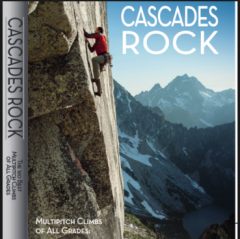
first ascent [TR] Gunsight Peaks Traverse - "Gunrunner" IV 5.10
Blake posted a topic in North Cascades
Trip: Gunsight Peaks Traverse - "Gunrunner" IV 5.10 Date: 7/11/2007 Trip Report: John Scurlock Photo A long-winded TR from a long, windy climb... The Gunsight range is a N-S trending ridgeline of fantastic granite near the southern end of the Ptarmigan Traverse. With four named summits over 8,000' tall and several intermediate pinnacles, it made the perfect candidate for an early July destination. Dan Hilden (Dannible) and I spent 3 full days climbing up there this week, and completed 2 new routes, plus the second ascent of the E. Face. The first day we were tired from the approach, so we didn't aim for anything too big, but found an exciting climb anyhow. I'll let the pictures tell the story... The route begins in the obvious corner which splits the face. We had to downclimb into the icy moat, so the first pitch is about 15' longer than it looks. The first pitch was splitter fingers/hands and ended at a nice ledge. Dan escapes the moat... The next pitch Dan lead around to the right, then straight up through wild loose overhanging chimneys. Here's looking straight down past my shaking toes: The last pitch was an easy romp to the summit where we found great views of Dome and Sinister. Artsy rope throw photo on the descent After playing in the spotlight of a natural cannonhole, we headed back to camp and sorted gear out for the next day. On July 9th we circled around the range along the Chickamin Glacier to the north end, well past the NE peak. We found some great hand cracks which lead to the ridge crest at its terminus and began the traverse. Wide stemming into a perfect hand crack... From the ridge crest we climbed south on fantastic granite above the Chickamin and Blue Glaciers. N->S allows you to climb the steep North faces and descend the south sides of the peaks. Pitch 2 climbs to the left (East) side of the crest and featuresan amazing 5.8 corner and face crack. The day definitely had more of a "climb" feel than a level traverse, and we'd both fully recomend it if you have a complete day in the area. Along the way we had one single rap from the NE peak and one double rap from the middle peak. The fourth pitch on the route was a well-protected face climb leading to an exposed roof on golden rock. We summited the Northeast peak in 7 or 8 pitches, and the climb to there would be a fun grade III. The last pitch to the NE summit actually began by circling around to the right (West) and climbing a chimney and then through the hole in the back of an enormous roof to the top. From there it was on to the North and Middle summits. The West face, in profile on the right, is still awaiting a FFA. There was one spot while climbing up the the North Peak where we were in a face crack which ended, so we pendulumed to the right to join other features. Apart from this bit of aid, the entire climb was done free, and I think we could have avoided it if we had looked ahead more carefully. By the time we summited our third peak (the middle one) I was feeling dehydrated and exhausted, but Dan found his second wind and led on as the sun set. He lead up to the top of the South Peak as the stars came out in force, and we rappeled down onto the Blue Glacier in the dark. The next morning we went to the East Face of the middle peak to climb the route which Sol (Frosty_the_tradman) and friend did last summer. (By the way, congrats to Sol on getting married last weekend, your route is fantastic too!) We broke up the pitches differently, and belayed on comfy ledges. See their trip report for more details. Above this splitter hand crack step right then up the finger crack and continue up the crack in the R-facing corner, over the lip(crux .10d), and to a big ledge. This elminates the need for a hanging belay and as long as you save one hand-sized cam for the last 15', it should be easy gear-wise, because of changing crack sizes. The second to last pitch features a beautiful delicate slab climbing. This face is in shadow all afternoon, and the sunset topout gets a Blake-and-Dan thumbs up. This was a fun trip and Dan is a great partner and camp chef. It was nice climbing with another young punk for once, as we have a combined age of only 41. [edited to add topo -porter] Gear Notes: Single cams Blue alien, #3 Camalot, #4 Camalot Double cams Green alien - #2 Camalot One set of nuts Crampons, Ice axe Should have brought more pringles... Approach Notes: Agnes Creek via Stehekin 3786-3784-Gunrunnertopo.doc- 41 replies
-
- north cascades
- traverse
-
(and 2 more)
Tagged with:
-
Trip: Denali - Denali Diamond Date: 6/19/2007 Trip Report: At Colin's and others' request, I'm posting as a trip report an email I already sent out to friends, with a few additional photos added. Enjoy. -MW We flew to Kahiltna base camp on June 2nd and over the next several days ascended the west buttress of Denali to the 14,300 foot basin. We arrived here with 3 days of food. We would leave 10 days later with at least 4 times that amount. On our 9th day on the mountain, we went from 14 to the summit on a nice day… joined by over 100 other folks who had camped up at 17,000'! Here's the fixed lines two days earlier: Although it was a surreal experience, it was actually the first time I had ever summitted Denali by this route, and I have to say I enjoyed it plenty despite the crowds. As always, Colin enjoyed himself too: Two days later, Colin joined the extreme ski team and climbed the upper West Rib to the summit and skied the Orient Express in his mountaineering boots and miniature skis, while I gave an exertion cough I had developed some opportunity to recover. In ensuing days, the ski team went on to ski the Messner, Rescue, Orient, and numerous other steep chutes on both the north and south peaks of the mountain, taking advantage of some of the best ski conditions in many years on these features. A stretch of mostly good weather during this week also allowed our friends John (Jedi) and Evan to climb the Cassin Ridge in 3 days after they took a chance on an ambiguous forecast that yielded bomber high mountain weather. Their successes were contagious and fired us up. On the evening of the 16th, we descended to our "basecamp" at 7,800' at the junction of the northeast fork, and the following evening left this camp for our planned route: the Denali Diamond, a 3500' granite wall left of the Cassin Ridge. The route then continues up an additional 4500 feet of steep snow terrain alongside, then on, the upper Cassin Ridge. We made rapid progress up the northeast fork despite unfrozen snow conditions and reached the bivouac crevasse at the foot of the Cassin Ridge in 5 ½ hours from 7,800'. We spent the day resting as light snow fell and visibility remained limited, but a forecast for 2, possibly 3 days of sunny skies and high pressure kept us optimistic. At midnight that night, the clouds evaporated and we began climbing. We simul climbed a half dozen easy pitches of snow and ice to where the wall steepened. I then led several easy to moderate mixed pitches with some simul climbing. The route unfolded beautifully, with astounding rock quality and well iced chimneys and grooves that provided continuously stellar climbing. Colin led a block of pitches up some wonderful mixed terrain that brought us to the "Diamond", an enormous block that dominates the wall. I then led a very steep squeeze chimney filled with ice, followed by a difficult mixed pitch. Soon we found ourselves entering the final crux corner system that leads to the snowfields hanging above. Colin led two very steep waterfall pitches (5+) which held sustained and continuous 90 degree sections. I thought these quite reminiscent in terms of difficulty and quality to the "Shaft" on the Moonflower of Mt. Hunter. The first of these leaned left and actually overhung in places, requiring some delicate and technical stemming: The second pitch began with a short but technical M6 mixed step, followed by relentlessly vertical but excellent ice. As with everything we had climbed to this point, the protection and rock quality was absolutely superb, allowing us to focus entirely on the climbing, and maximizing our enjoyment. A short ramble above the second step led us to the infamous crux pitch. To the right, the FA party's notorious 25 foot, A3 roof loomed. This looked very intimidating. Just left of this was an even worse looking chimney (unclimbed): Just a bit further to the left, the main corner continued above as a 40 meter, vertical, inside corner, with no ice. This pitch, climbed by the 2nd and 3rd ascent parties, had never been freed, but was estimated at M7. The plentiful cracks assured us that it would go one way or another, but at this point in the day (15 hours) our primary goal was simply getting the rope up there. We brewed up some water as the afternoon sun began to blaze upon us- our timing was working out as hoped, climbing the hardest part in the warm sun. Colin started up and the climbing proved quite hard. After 20 meters of mixed free and aid, he belayed, to recover some pieces that would be needed above. I belayed from a fully hanging stance while Colin worked out more mixed free and aid climbing to another belay 30 meters higher. Following with both packs was a major pumpfest. Above, instead of the easy terrain we were now hoping for, we were treated to 2 more pitches of M5-ish climbing in icy, awkward chimneys, before we abruptly exited into the massive snowfield paralleling the upper Cassin Ridge, at about 16,000'. It was 9 PM, hour 21 since leaving the base. Although the Alaska Range was surrounded on all sides by enormous thunderheads, the weather up here was beautiful and windless, a perfect day to be on this huge face. Finding only hard ice and thin snowcover, we were forced to climb another 600 feet to find snow deep enough to obtain a tent ledge without having to chop into ice. Both of us were now very dehydrated and therefore pretty much knackered; as such, this last section of "easy" climbing was, for me at least, the mental crux of the whole climb, and I had to dig deep. Once settled in the tent we could begin repairing the deficit we'd put ourselves in, brewing up much water and eating a good meal. We then slept soundly in Colin's custom 2 person sleeping bag; between this bag and the BD firstlight tent, our bivi setup weighed almost nothing yet allowed us enough comfort to get a good rest. Day 2 was bright and sunny, so we slept in and did not begin climbing until 2 PM. This day was like a whole different climb: all snow climbing, and at altitude. We broke trail in variable snow conditions for over 3 hours before finally joining the Cassin around 17,500'. Anticipating a cold, late evening summit, we stopped at 19,000' to brew up in the evening sun and prevent a repeat of the previous day's dehydration. Smoke from lightning caused fires began to infiltrate the mountains, but otherwise it was relatively warm and beautiful. At 9:45 PM we stood alone on the summit in a cold stiff wind, happy it was now all downhill from here. Our time on the 8000 foot face was 45 hrs, 40 minutes, and this was the route's 5th ascent. At just after midnight we reached the tent and food we'd left behind at 14,000 on the west buttress. The weather shut down the following afternoon. I love it when the timing is this perfect. We remained on the mountain for another week: me at Kahiltna basecamp with Lisa, Colin at 14,000 in hopes of some further climbing; but, the weather would not allow it. On the positive side, with the right connections, Mountain High Pizza Pie delivers to basecamp in 90 minutes or less: Gear Notes: Standard alpine rack to 3", 6 screws (mostly 13's), handful of pins of all types, lots of slings, a light pack, and a good weather forecast. Approach Notes: The Northeast fork of the Kahiltna is always a heads-up experience, but don't let rangers or British climbers tell you it's near-impossible. Go look for yourself, move fast, and use common sense.
- 28 replies
-
Trip: Salish Peak & Roan Wall linkup - 17 pitches 5.10+ - Date: 6/20/2007 Trip Report: Yesterday Darin Berdinka and I climbed two new grade III routes near Darrington. The are both recently completed and feature flawless granite in a beautiful spot. We did them in a day 16 hours round trip. Approach using the Squire Creek Trail towards Three Fingers, and the Roan Wall is on your right, easily noticeable from the head of the valley. Ours was probably the 4th ascent of both of the routes, but they deserve lots of visitors. The Roan Wall has a 5.8 bolted pitch, a 5.4 cracks pitch, then a bit of scrambling before 8 more pitches up the steep wall. Mostly small edgy face climbing, although the last 3 pitches have cracks mixed in. Locate bolts on the above bulge to begin climbing. The 5th (crux) pitch involves a leftward move close to the belay The last 3 pitches have fun crack climbing. Then you top out and are a short walk from this: Scramble off the top of the Roan Wall by walking along to the left, then across to the base of Salish Peak. Every pitch is mixed crack and face, with lots of fun exposed moves. The 3 hardest moves are all somewhere in the 5.10 range and you could AO on a draw. Pitch 1 Darin had told me that the face move was 5.11something and I A0ed without trying it out. He freed it on TR and said it was more like .10c The 6th pitch was spectacular face and crack... maybe the best of the route. You can rappel the route in 5 double-rope rappels, using fixed stations. The black webbing/grey mammut runners are ours. From the base of the route, we high-tailed it back to the car in 3:40, because I insisted to Darin that we complete the day wihout headlamps. After all, the solstice is good for something, right? (The trailhead is at the base of the landslide in the distance) Cheers to Chris Greyell for putting up the routes, and to Payless Shoes, whose $20 sneakers passed the test. Also, the gas station in Darrington gives out all its hot food for free after 10pm:hcluv: , so thanks to Darin for putting up with my erratic driving when my hunger-crazed brain payed more attention to Taquitos than turns on the highway. Darin was a great partner even though he originally tried to get me to leave Bellingham at 2:30 AM! This linkup is one of the best rock climbs I've done, it should be high on the to-do list!
-
Trip: Mt. Robson - Emperor Face, House-Haley (FA) Date: 5/25/2007 Trip Report: Excited by a good forecast, Steve House drove north from Bend on Wednesday afternoon for his 7th attempt on Robson's Emperor Face. Fortunately all of the more talented climbers he approached could not go, so we met up in Seattle and hit the road up to Robson on Thursday morning. On Thursday afternoon we flew with Yellowhead Helicopters to the Helmet-Robson col, and left the col at 4:30am on Friday to approach the Emperor Face by descending the ramped ice-fall above the Mist Glacier. We climbed the face in two long lead blocks, both seven pitches long. My block had longer pitches (about 80m on average) and moderate climbing, then Steve's block had normal-length pitches (about 55m on average) and much more difficult climbing. Our route roughly followed the gully system immediately left of the Stump-Logan, but on the last pitch we suddenly encountered 3 fixed pitons. Presumably Stump and Logan finished a little bit to the left of the arete that is shown in most photos. Our route shared at least the last pitch with theirs, and perhaps the last two pitches. I reached Steve's belay at the top of the headwall at 11:30pm, and we spent the short night sitting on a small ledge chopped from the ice. In the morning Steve led two easy mixed pitches up to the crest of the Emperor Ridge, which we then crossed onto the upper SW Face. We traversed across the South Face, me now feeling very sick for some reason (I think a bug that I have had ever since Patagonia), and joined the Wishbone Arete in deteriorating weather. The upper Wishbone Arete included some funky gargoyle climbing, and we topped out in a whiteout at 1:00pm. We descended the Kain Route and then Steve hiked up to retrieve our camp at the Helmet-Robson col while I sat and contemplated vomiting. Our camp-to-camp time was approximately 36 hours. On Sunday we descended the Robson Glacier (sometimes stressfully off route due to the whiteout), and then hiked down to Kinney Lake, leaving the last 7km of walking for Monday morning. I probably won't have time to post pictures until July, unfortunately.
-

best of cc.com CC.com Photo Contest 2007 Voting - VOTE HERE!
olyclimber posted a topic in Climber's Board
OK folks here it is...the long awaited CC.com photo contest voting. We got a little busy with other stuff (life, work, hospital stays, etc) so sorry it took so long, but here it is. The rules are simple....just like last year you can vote for one photo in each catagory. After 10 days, we'll check out the results and award the winners. Happy voting! The voting ends April 20th at 8pm, and you'll be alble to see the results then. The voting is at the bottom and finalist pictures are below for reference when voting: Catagory: Cragging Picture 1: Picture 2: Picture 3: Picture 4: Picture 5: Picture 6: Picture 7: Picture 8: Picture 9: Picture 10: Picture 11: Picture 12: Picture 13: Picture 14: Catagory: Alpine Picture 1: Picture 2: Picture 3: Picture 4: Picture 5: Picture 6: Picture 7: Picture 8: Picture 9: Picture 10: Picture 11: Picture 12: Picture 13: Picture 14: Picture 15: Catagory: Scenic Picture 1: Picture 2: Picture 3: Picture 4: Picture 5: Picture 6: Picture 7: Picture 8: Picture 9: Picture 10: Picture 11: Picture 12: Picture 13: Picture 14: Picture 15: Picture 16: Picture 17: Picture 18: Picture 19: Catagory: Skiing/Boarding Picture 1: Picture 2: Picture 3: Picture 4: Picture 5: Picture 6: Picture 7: Picture 8: There is no picture 8. Any votes for picture 8 will be disregarded. Picture 9: Catagory: Bouldering Picture 1: Picture 2: Picture 3: Picture 4: Picture 5: Catagory: Ice Picture 1: Picture 2: Picture 3: Picture 4: Picture 5: Picture 6: Picture 7: Picture 8: Picture 9: Catagory: Humor Picture 1: Picture 2: Picture 3: Picture 4: Picture 5: Picture 6: Picture 7: Picture 8: Picture 9: Picture 10: Picture 11: -
Trip: Utah Desert Tower Tour - Date: 3/20/2007 Trip Report: My wife Michelle and I just returned from a two week trip climbing desert towers around Moab, Utah. Overall we had a great trip, climbing 11 routes on 10 towers (actually 9 towers and 1 mesa). Our first stop was Arches National Park. We decided to warm up on Off Balanced Rock, North Chimney (5.7). The 100-foot runout on the second pitch was a little unnerving but luckily the chimney was fairly secure. Here's a shot of me taking a picture of Michelle coming up the chimney: On top of Off Balanced Rock: Next stop was the obligatory Owl Rock, Olevsky Route (5.9), definitely a must do tower for anyone visiting Arches. Michelle rapping off: That evening we hiked out to Delicate Arch for the sunset. Next it was time for the Fisher Towers. It rained a little the night we got there, so climbing Ancient Art the next day was out, as climbing dry mud is bad enough. Instead we did the really cool hike through the towers and out to a viewpoint. Later that evening it seemed to dry out enough to give Lizard Rock, Entry Fee (5.9) a go. Leading up: Michelle on top: The next day we headed up to do Ancient Art, The Corkscrew Route (III 5.10d) The route climbs up the central chimney then up the highest point on the left. Following the first bolted crux: The summit has to be one of the top five coolest spots in the world that I have been. We came back down and I decided to give a go at The Cobra (5.11 R). I mean, how much longer is this thing going to be there? I had to get it while I still could. Chalking up under the lip: One more day in the Fisher Towers and we wanted a little bit more, so we climbed the Kingfisher, Colorado Northeast Ridge (IV 5.8 C2). Kingfisher, the route ascends the left side of the tower: This was actually Michelle's favorite route of the whole trip! Not because the climbing was that great - mostly a bolt ladder with a few very C2 mud placements and some good free-mudding. But the overall line, exposure, and summit were fantastic. Looking straight down the Northeast Ridge: Summit views - The Titan, Echo Tower, and Cottontail Tower: Next stop was Castle Valley. We of course had to do the obligatory route on Castleton Tower- the Kor-Ingalls (III, 5.9). Castleton Tower: The route follows the central dihedral: The line is good, but the climbing leaves a bit to be desired. The crux offwidth is only cruxy because they tell you to bring so much god-damned gear up the route and you have to squeeze up the thing with all this crap. In reality you only need a number three Camalot and 4 quickdraws to lead the crux pitch. Anyways, cool summit. Michelle coming up the crux OW/Chimney: The Rectory came with many recommendations, and although it is a mesa and not a tower, it still has a tower feel and is a really cool desert formation. The Rectory is the Mesa in the foreground, the route climbs directly up the facing wall: We climbed Fine Jade on the Rectory (III, 5.11a). The first two pitches are the crux and are both interesting and sustained. The warm up pitch is a steep but short 5.10d hand-OW-hand crux. Michelle following the first pitch: We hiked across the Rectory to watch some climbers on the Honeymoon Chimney of The Priest. Climbers on Fine Jade, The Rectory: Later that afternoon we decided to climb the North Chimney of Castleton Tower (III, 5.9), as many people consider it the better of the two moderate routes. The first pitch was ultimately classic. Two parallel cracks, mostly hand jamming, and interesting moves for an entire 150 feet. The second pitch, however, was mostly junk and I linked all the way to the notch in exactly 200 feet. Michelle following the first pitch: The next mission was Sister Superior, Jah Man (III, 5.10c). Another fine desert route, with a stout but short crux on the 3rd pitch. And one of the finer chimneys in the area - the Sister Squeeze chimney on the 2nd pitch. Sister Superior: Up close: Looking down the 3rd pitch: On the summit looking toward Castleton and the Rectory: And for the final hurrah we took the long drive out and climbed Moses, Primrose Dihedrals (IV, 5.11d). Moses is the tallest tower: The route is everything it's cracked up to be - short but sustained pitches, interesting climbing, and an awesome position. Michelle coming up the 4th pitch: Pitch 5: Summit success: Gear Notes: SuperTopo: Desert Towers - a great guide for these routes. Approach Notes: High clearance 4x4 recommended - even for parking lots.
- 24 replies
-
- utah
- joy puryear
-
(and 1 more)
Tagged with:


